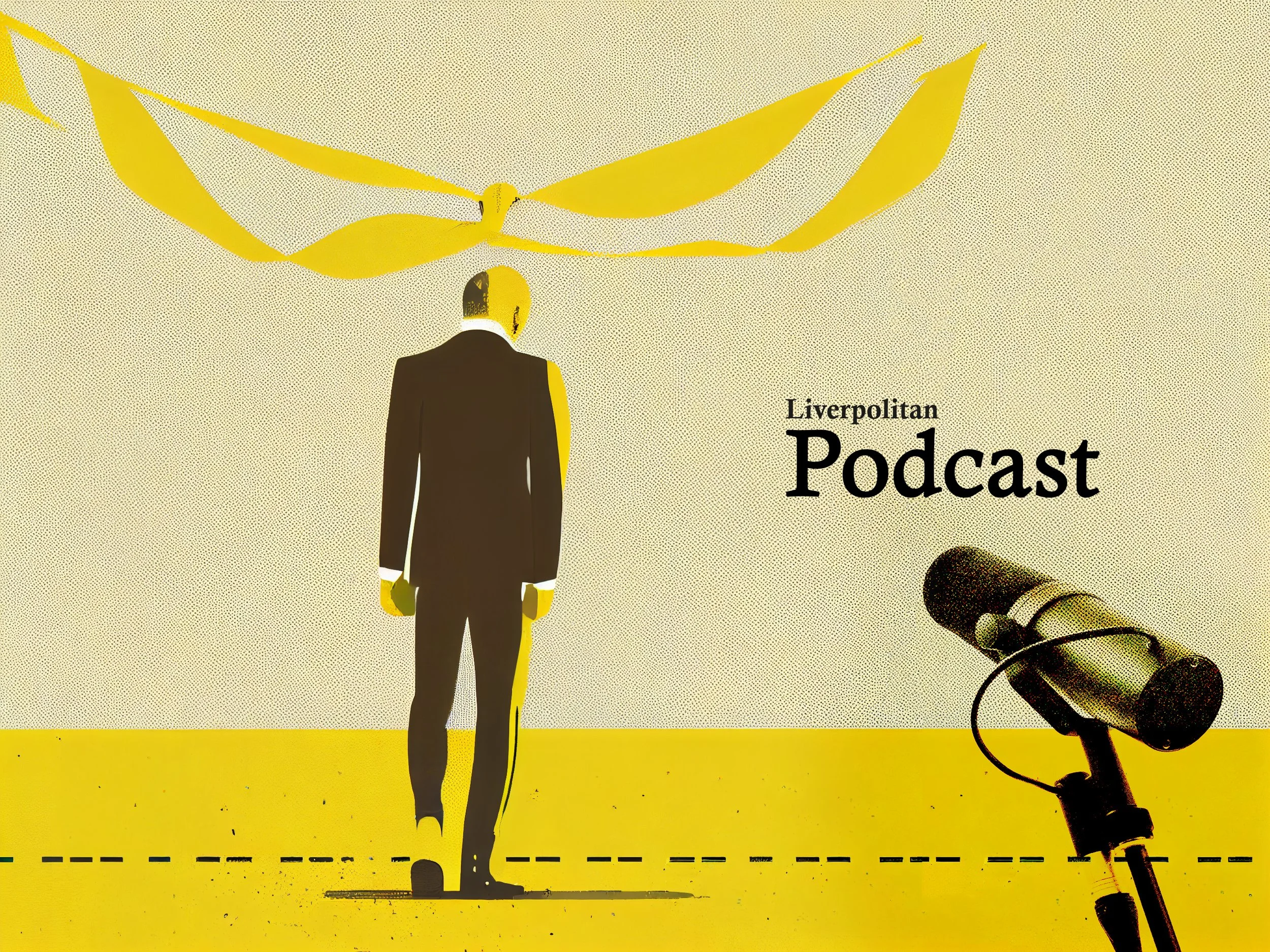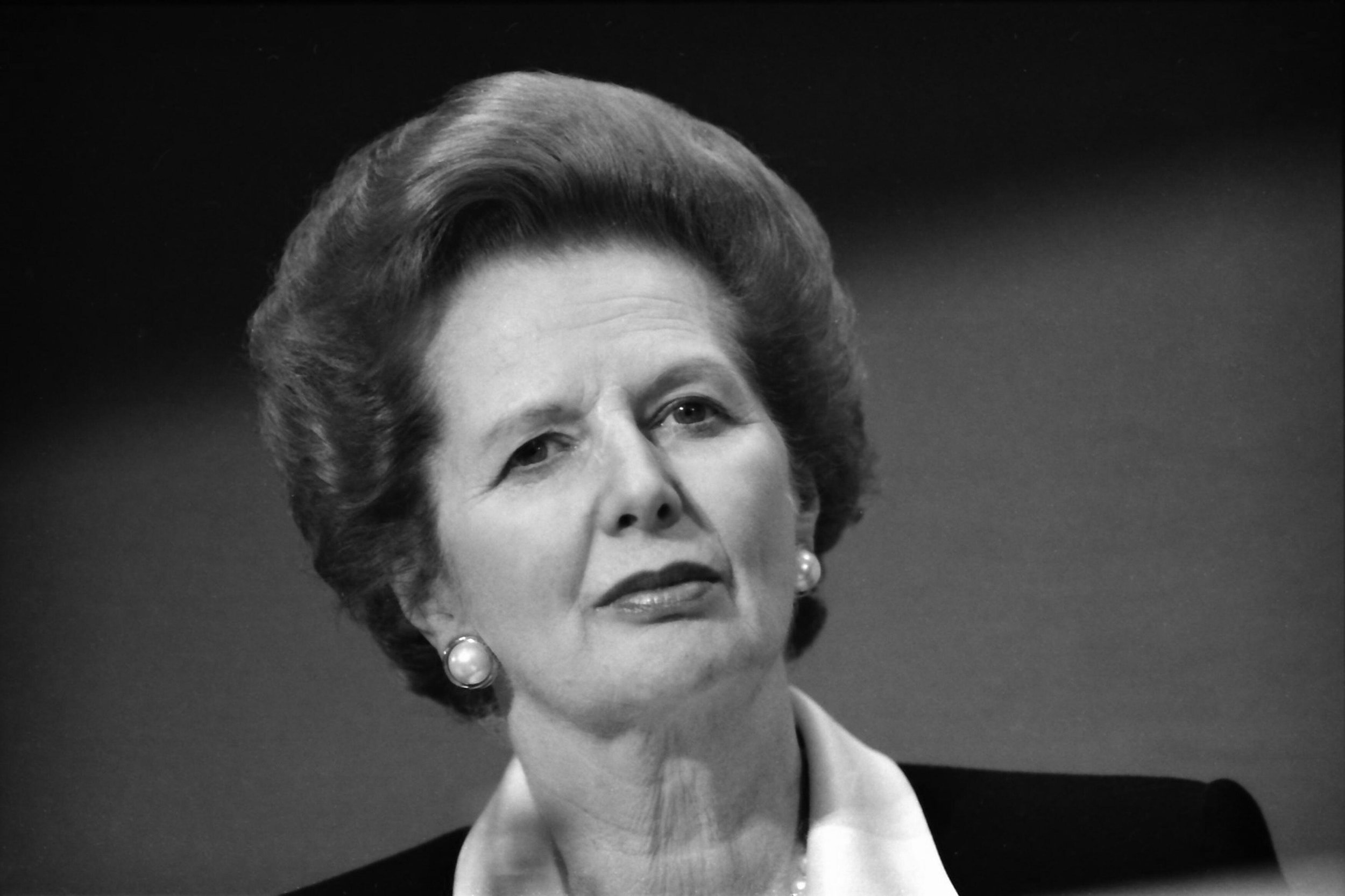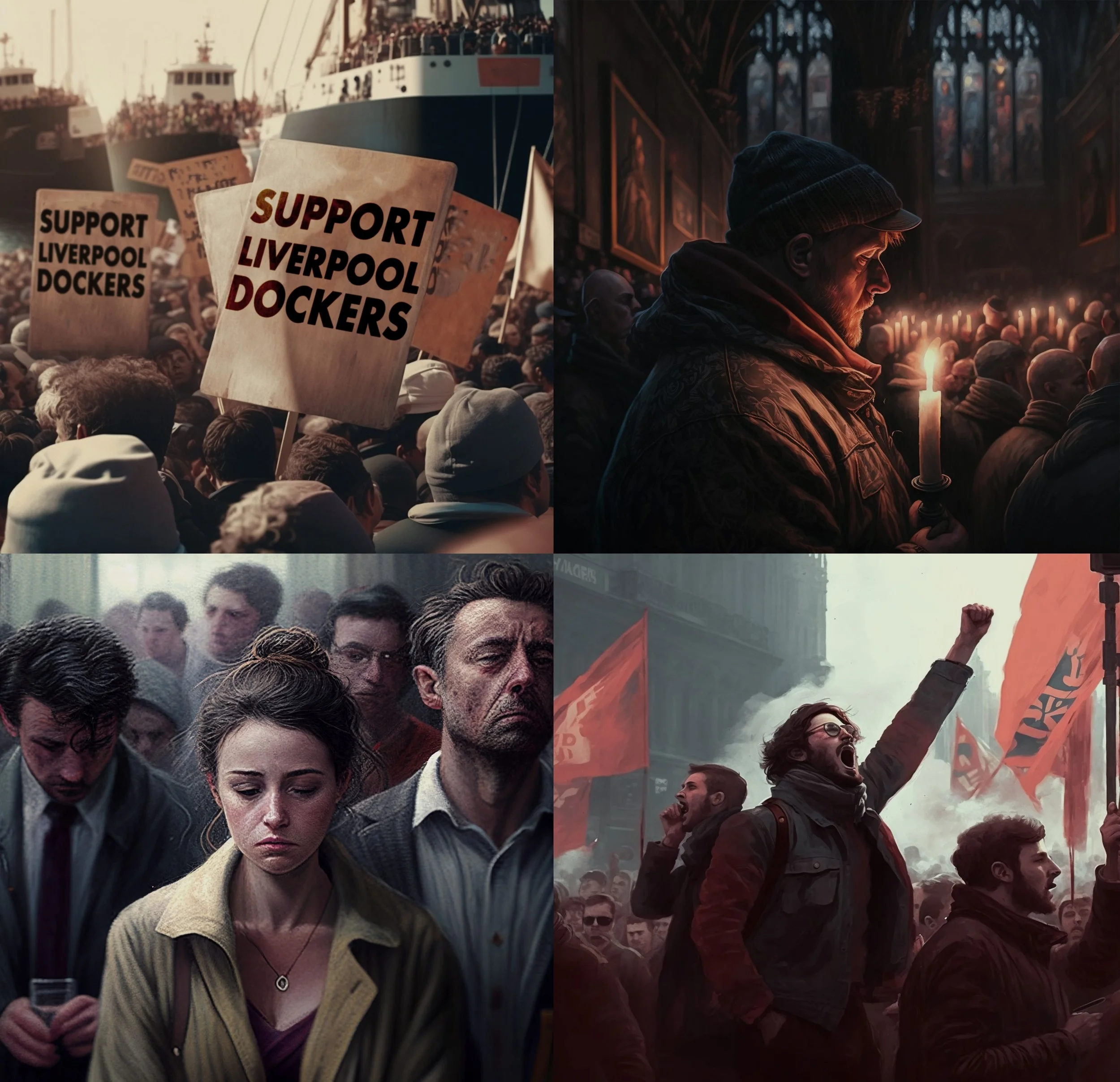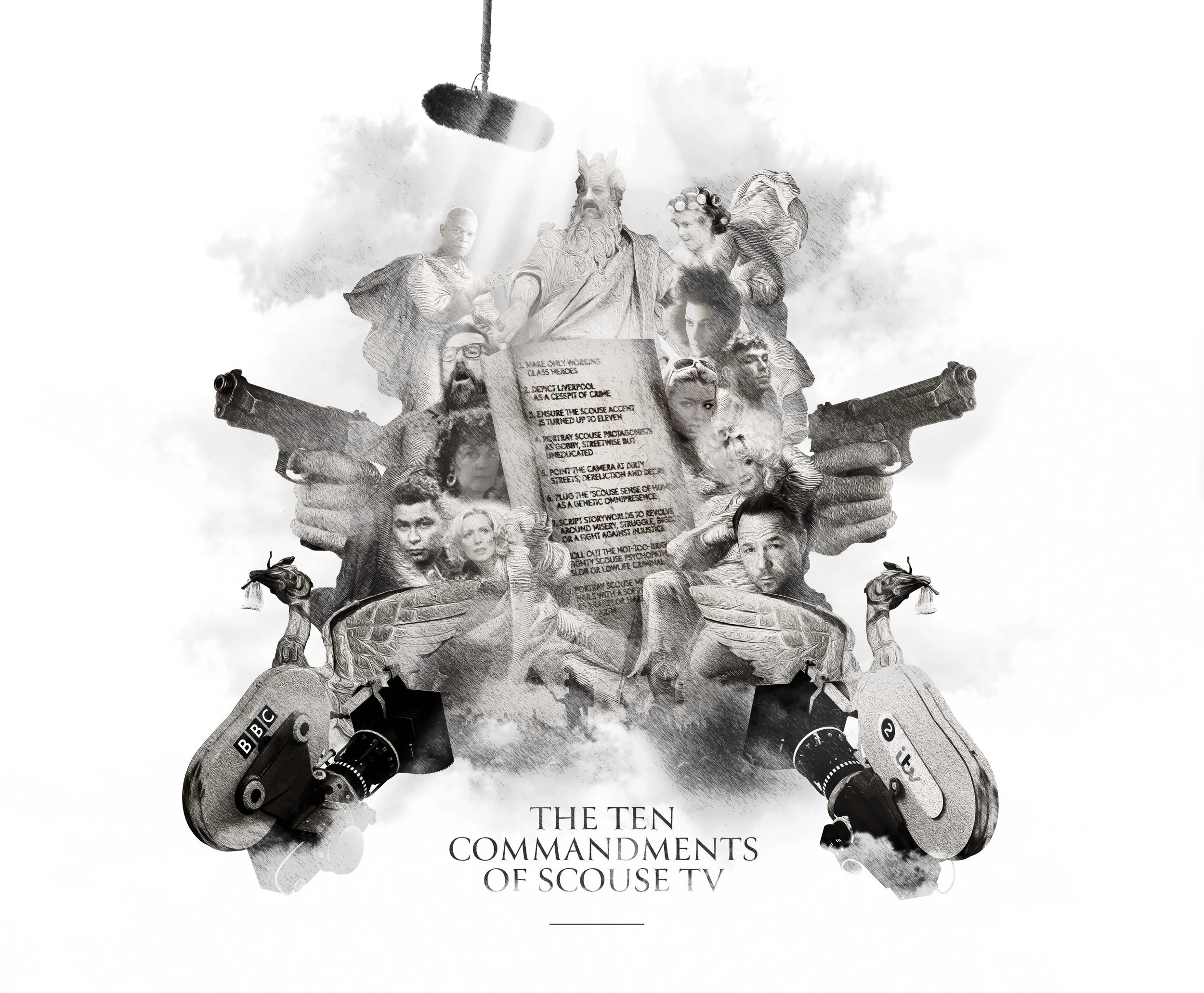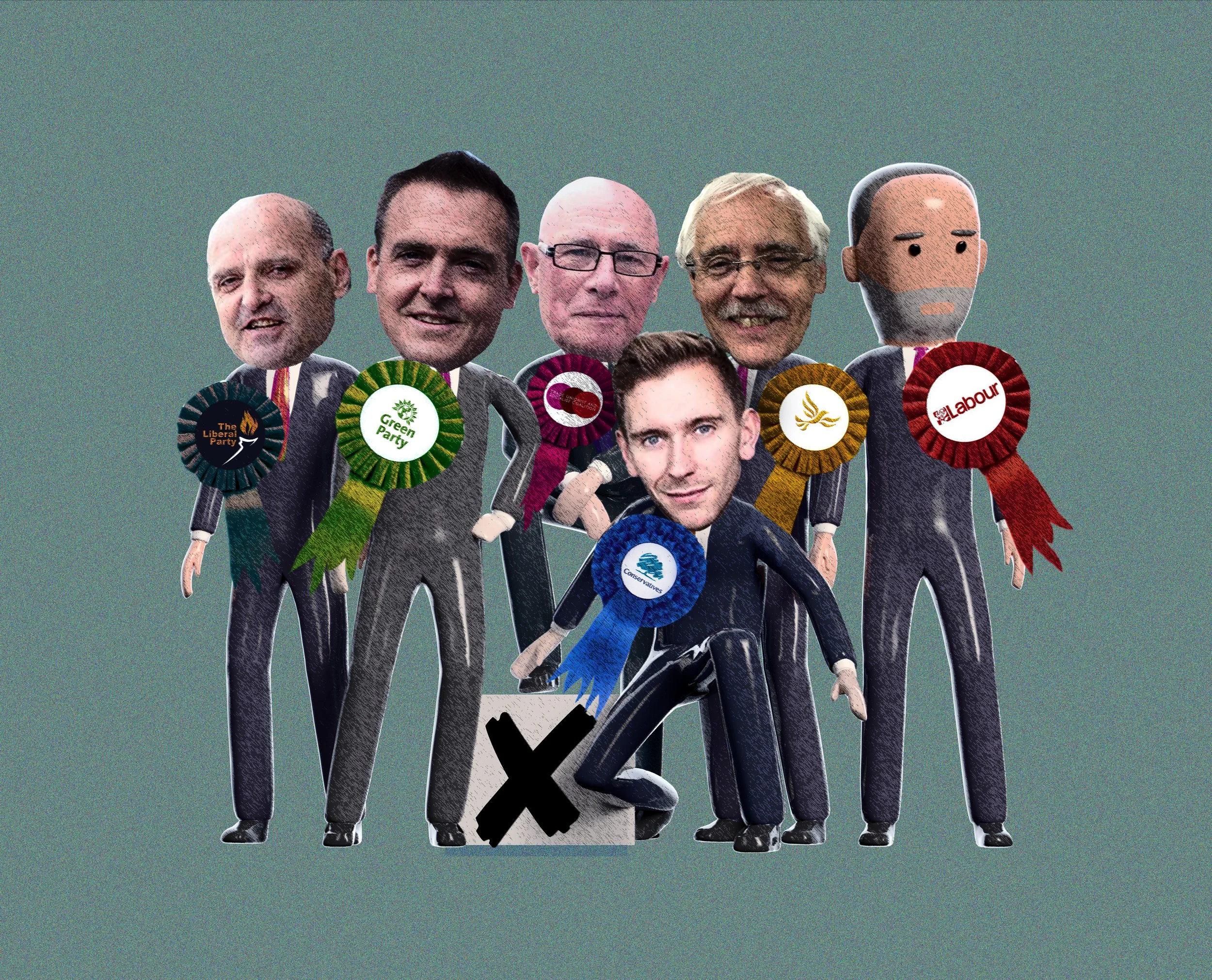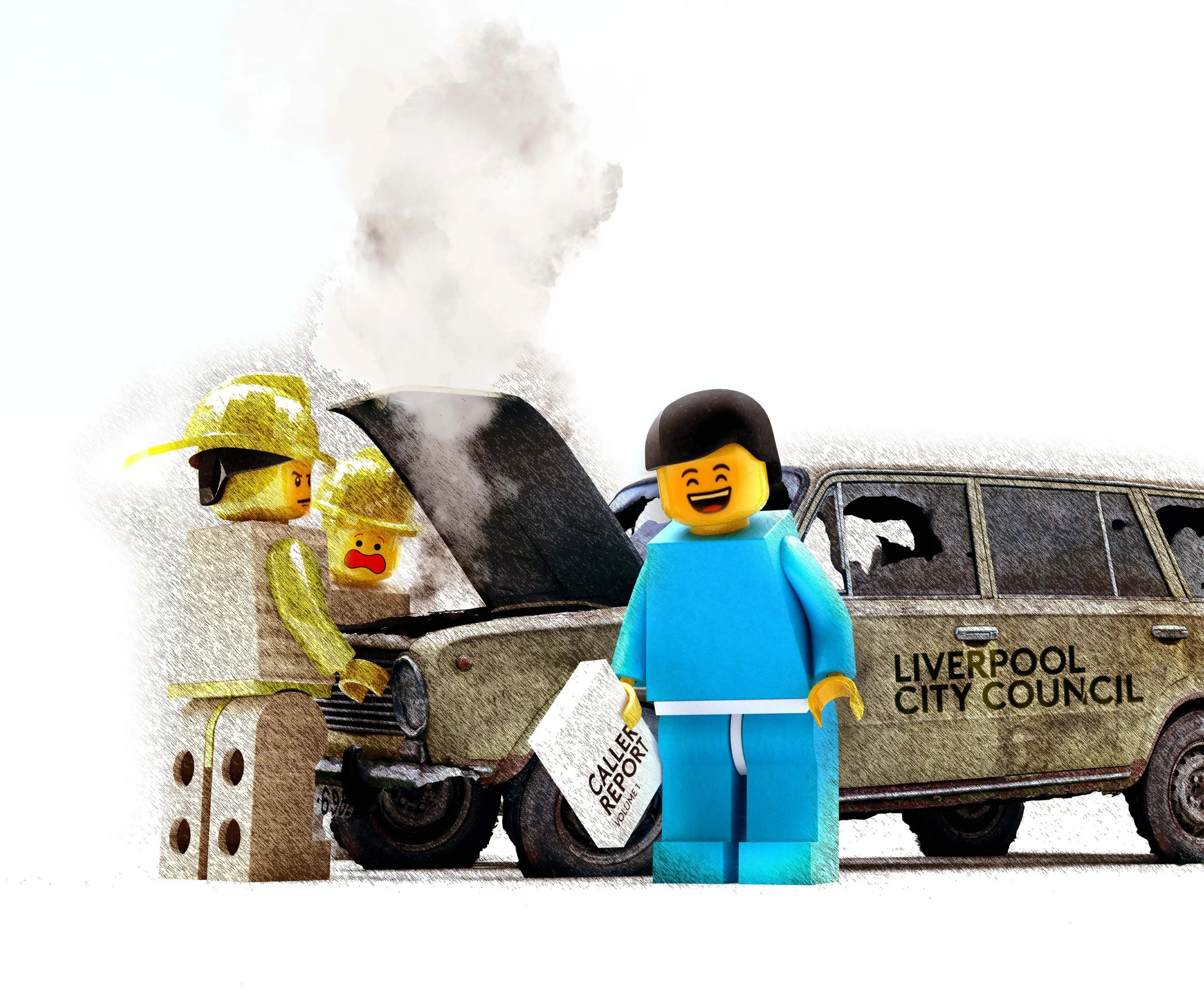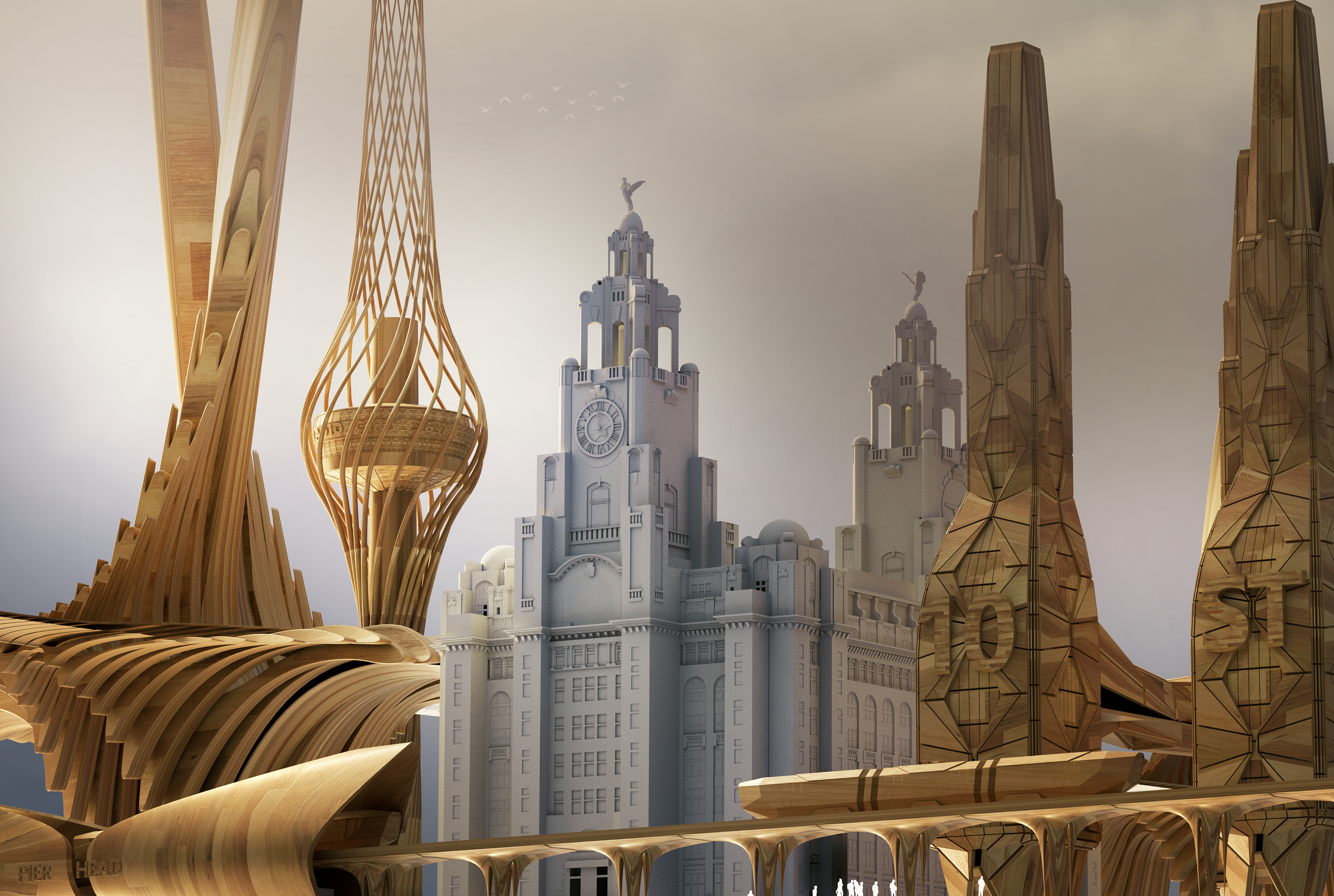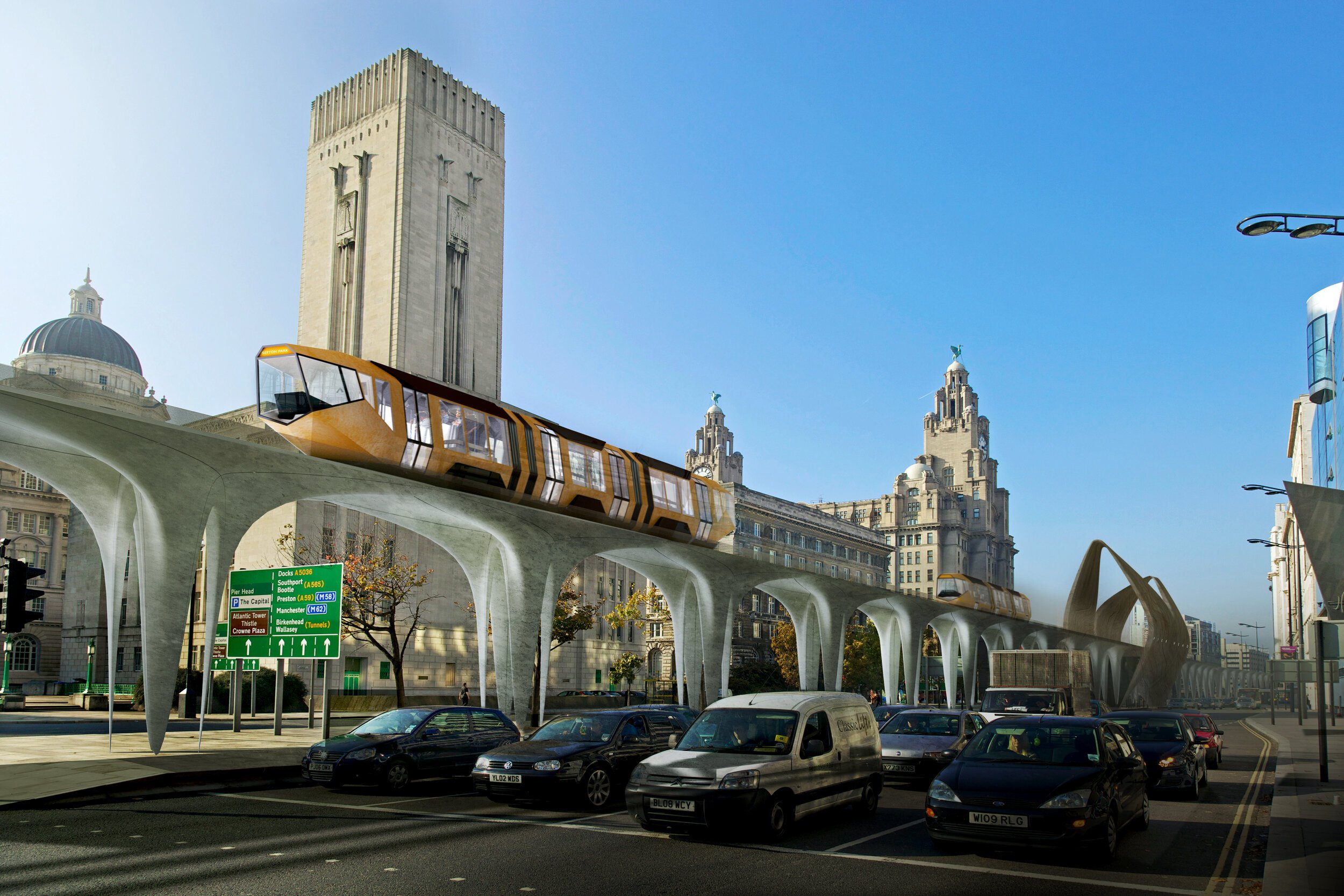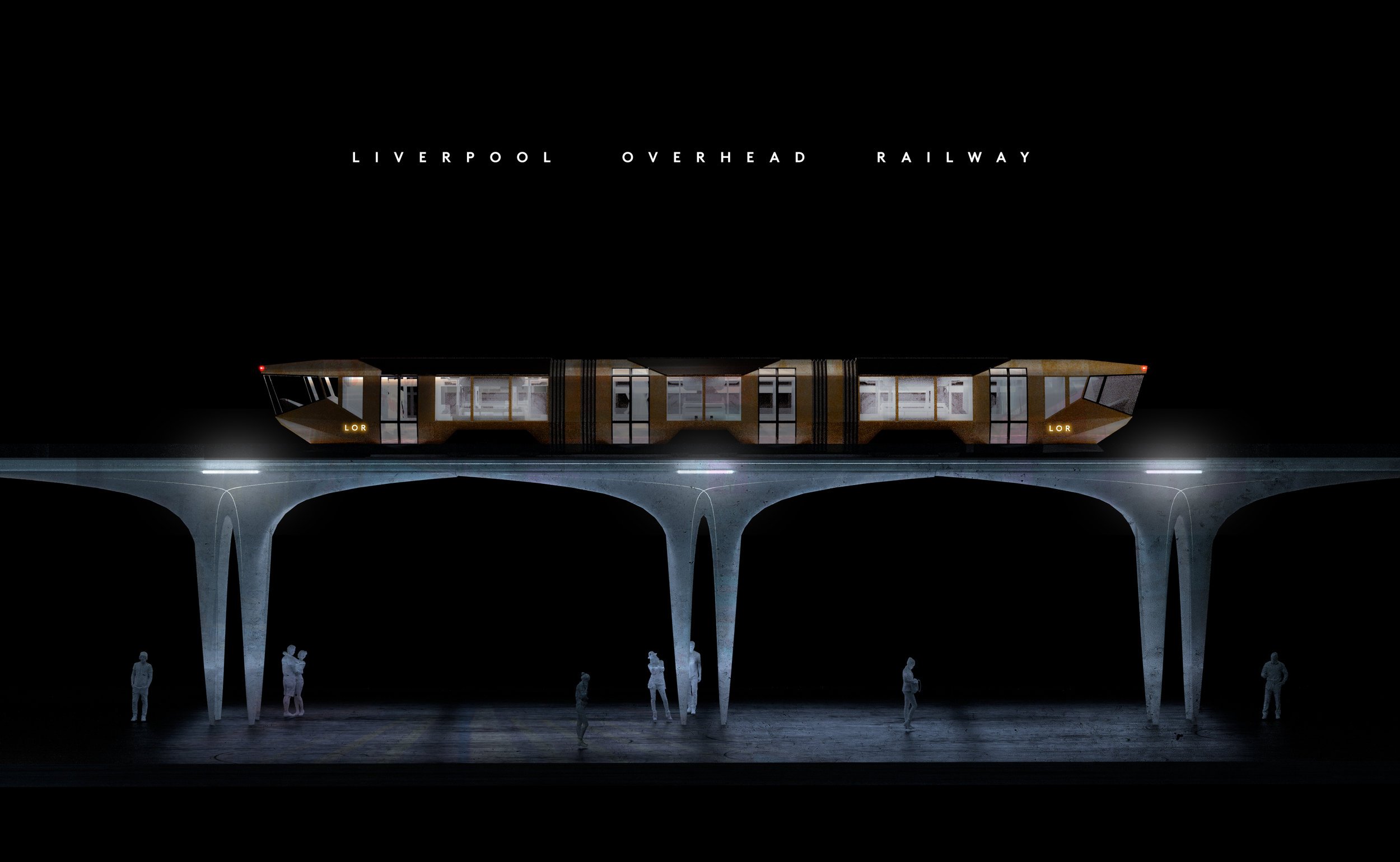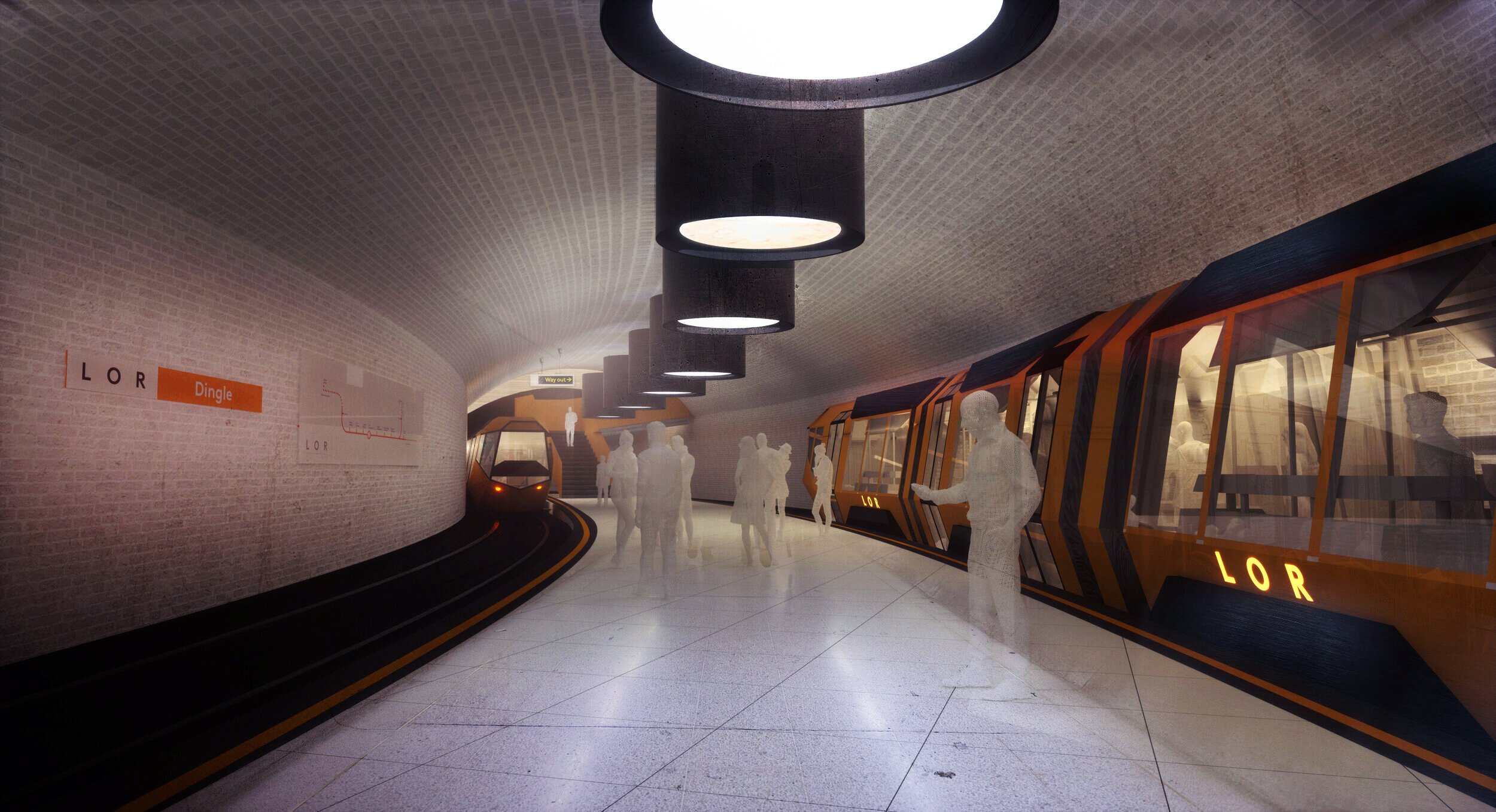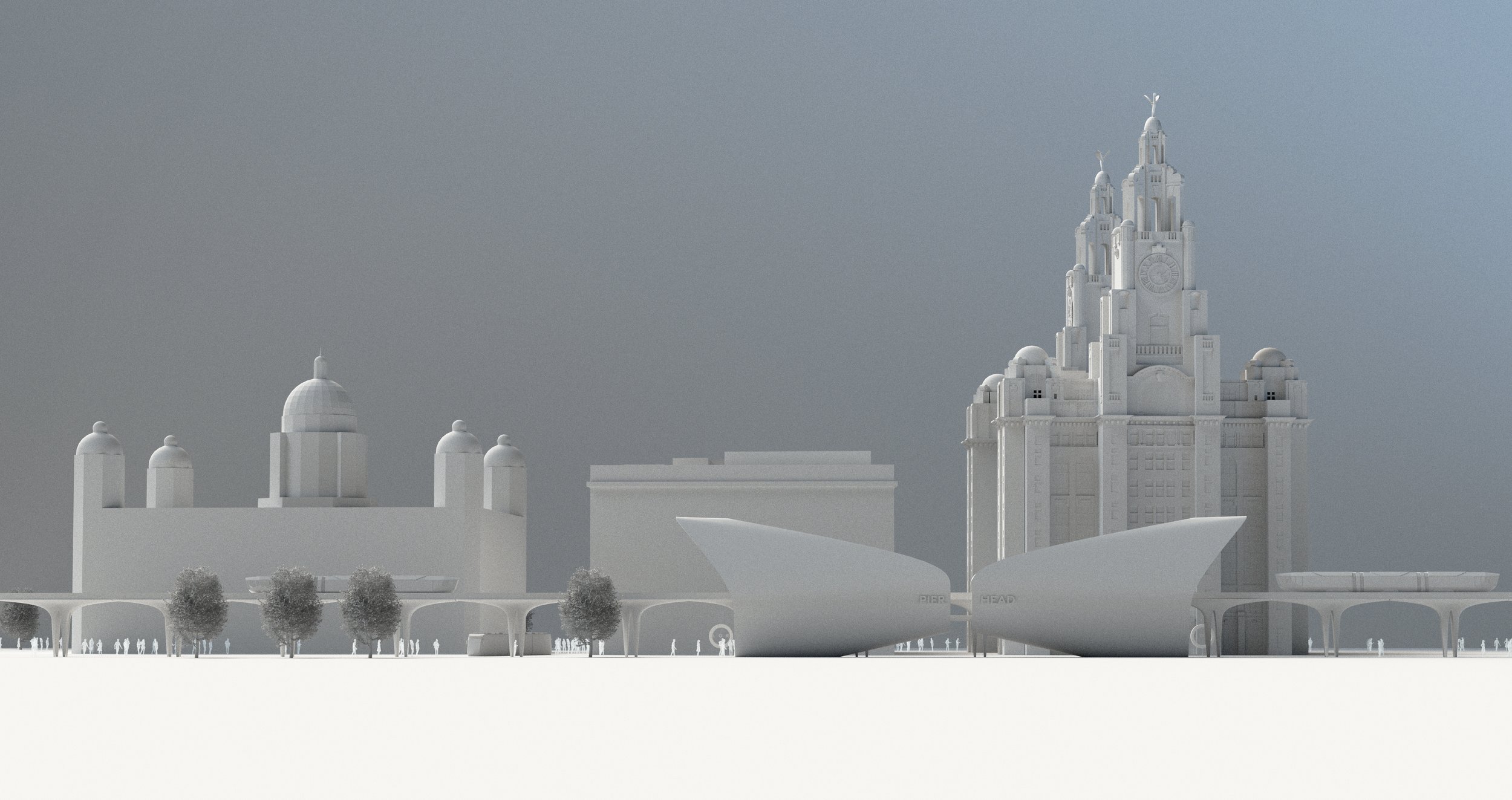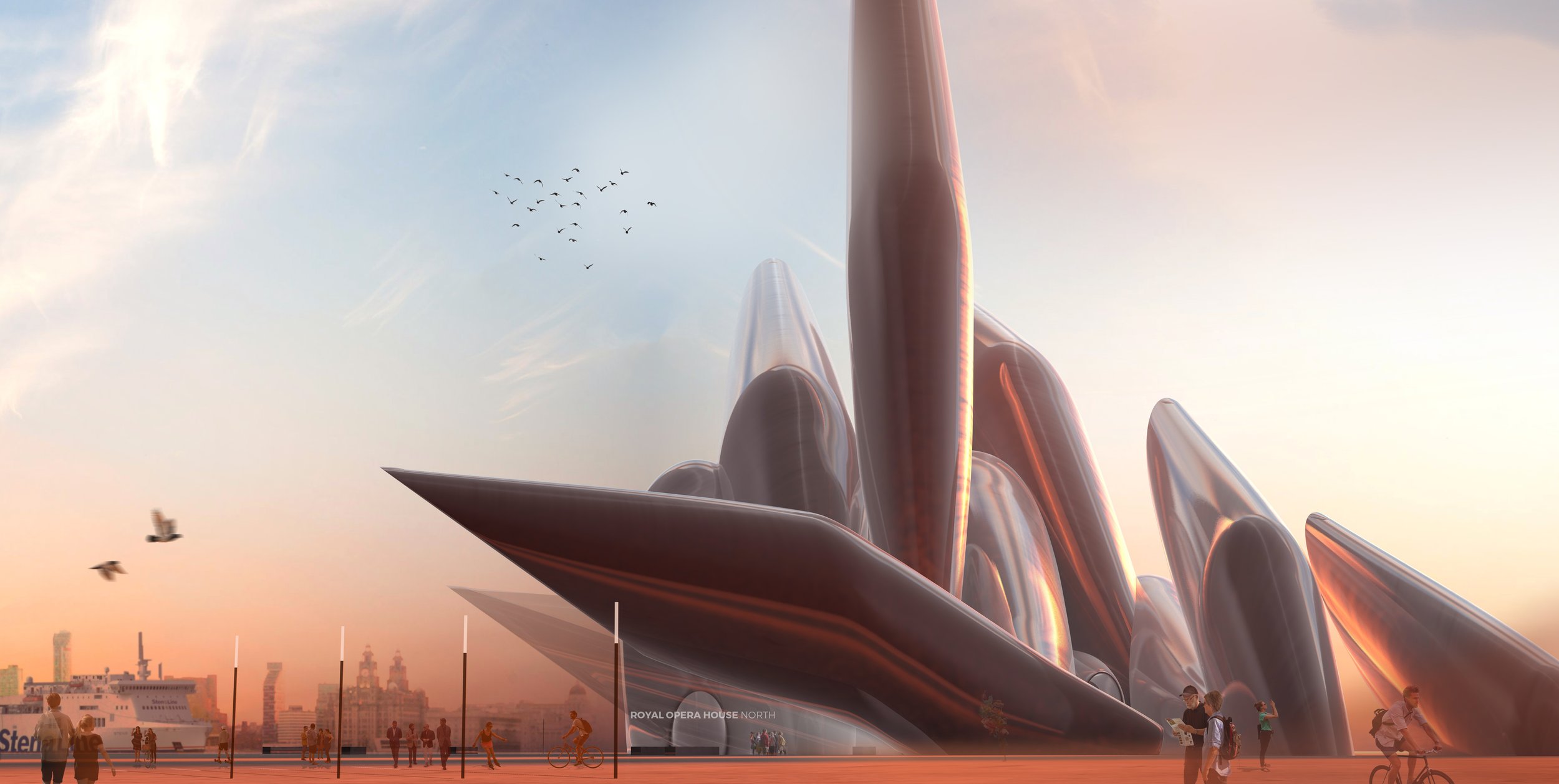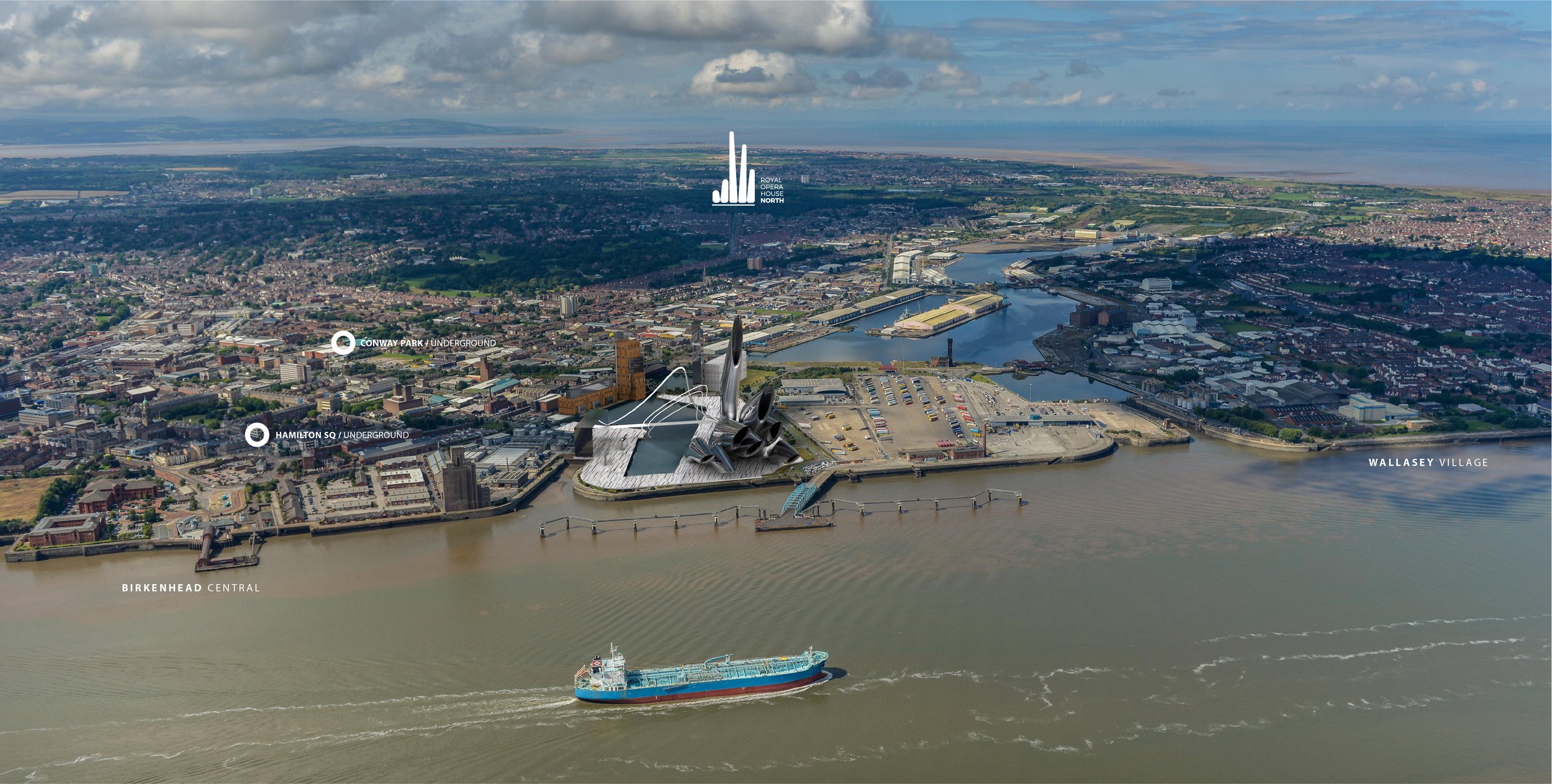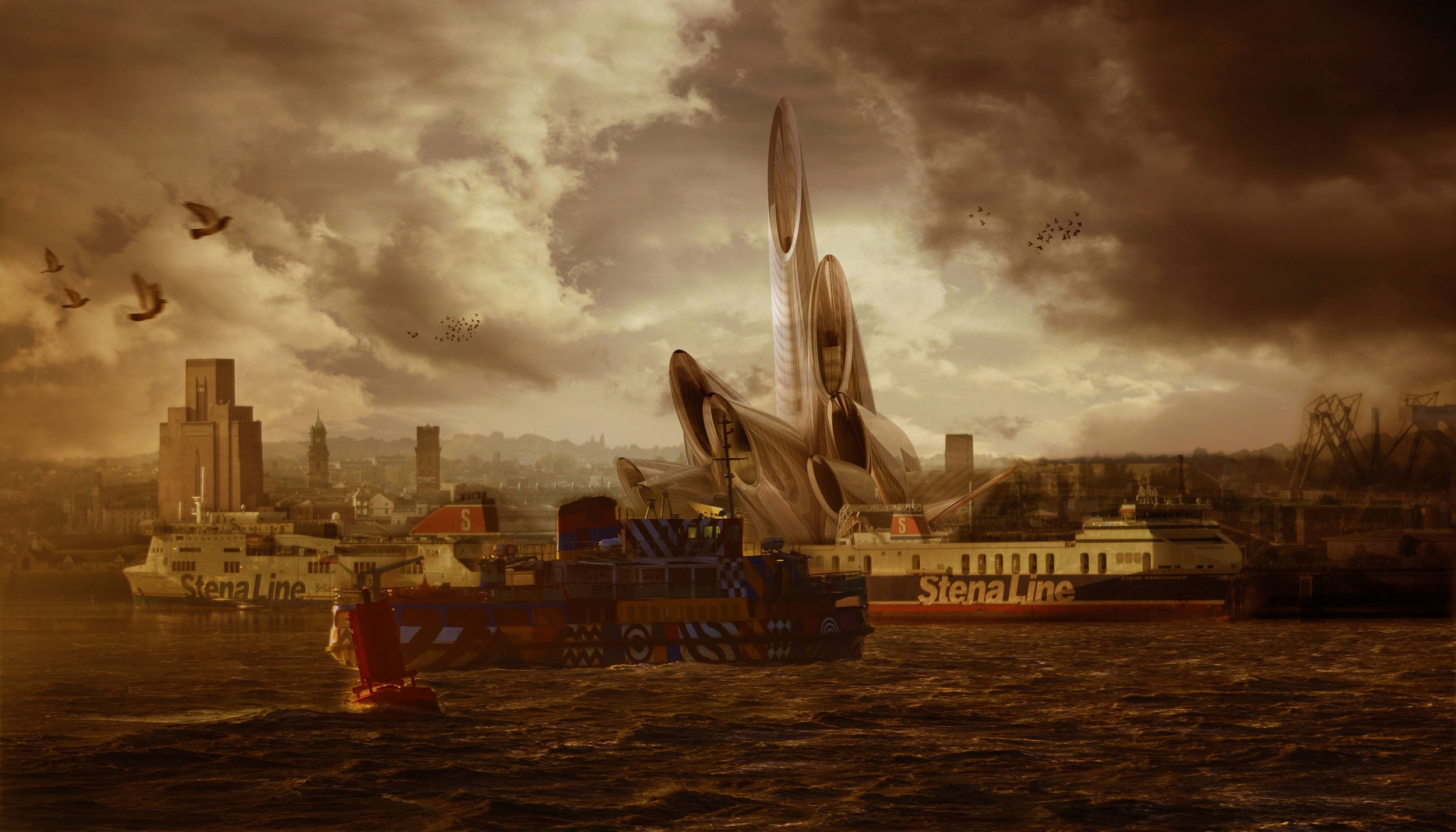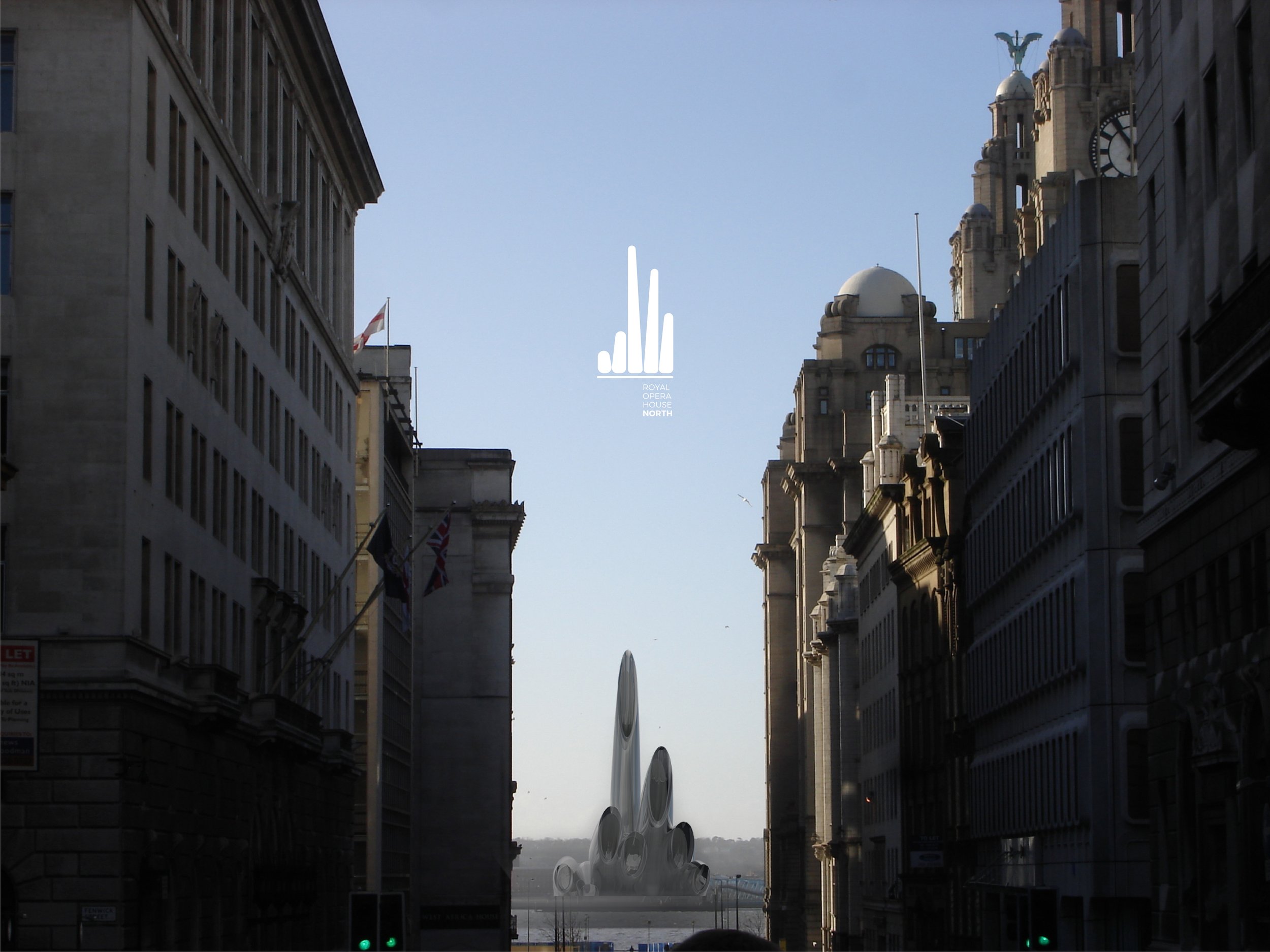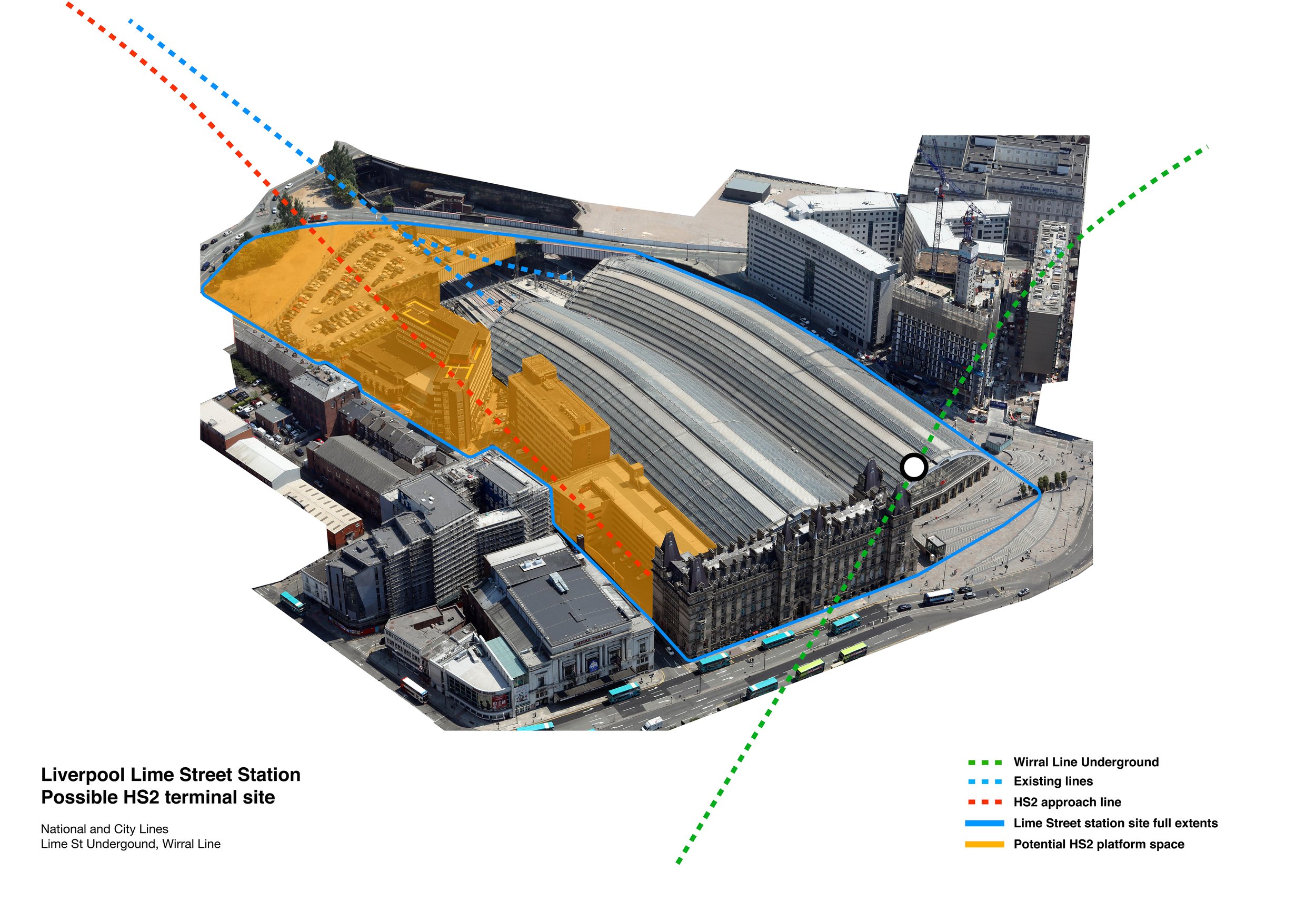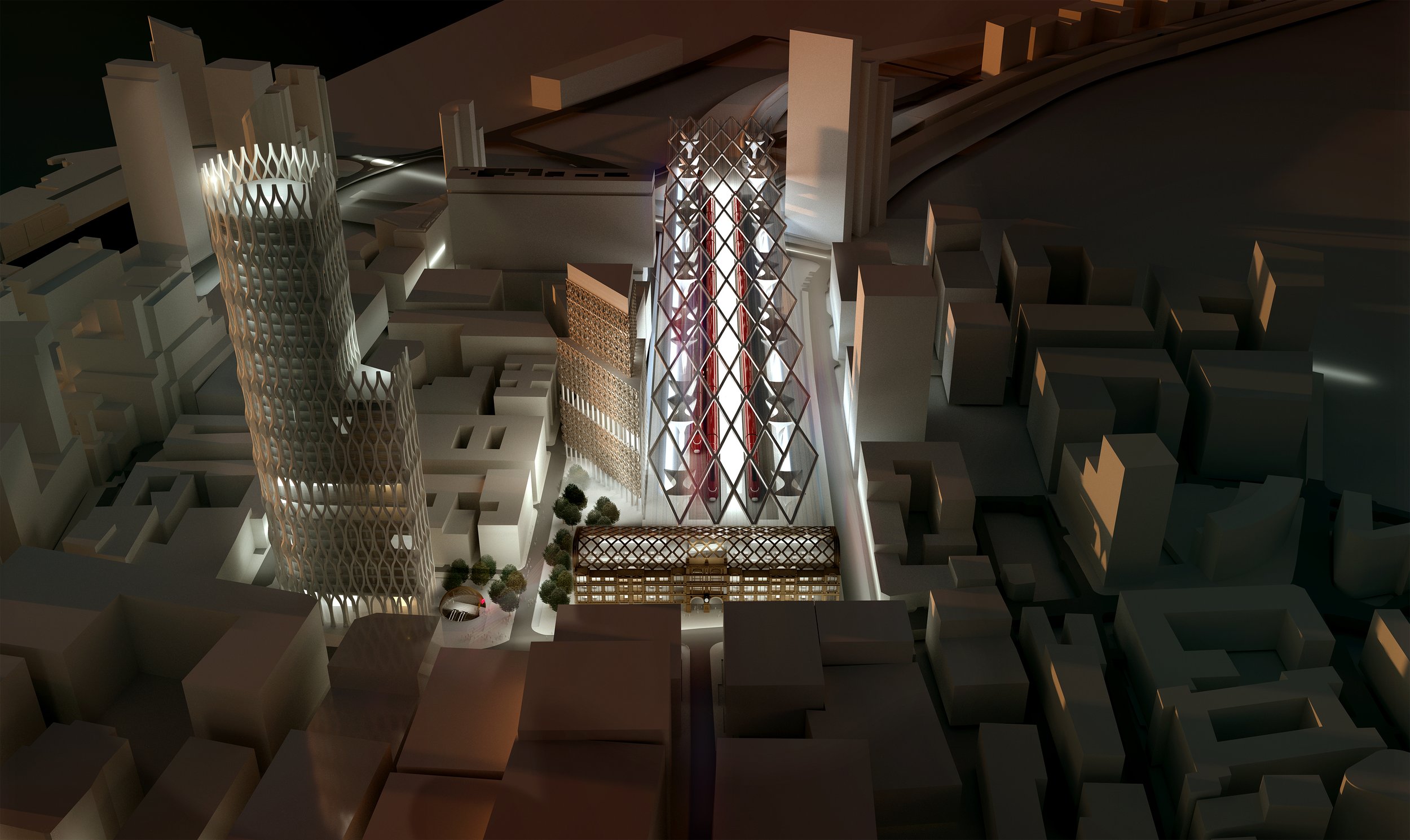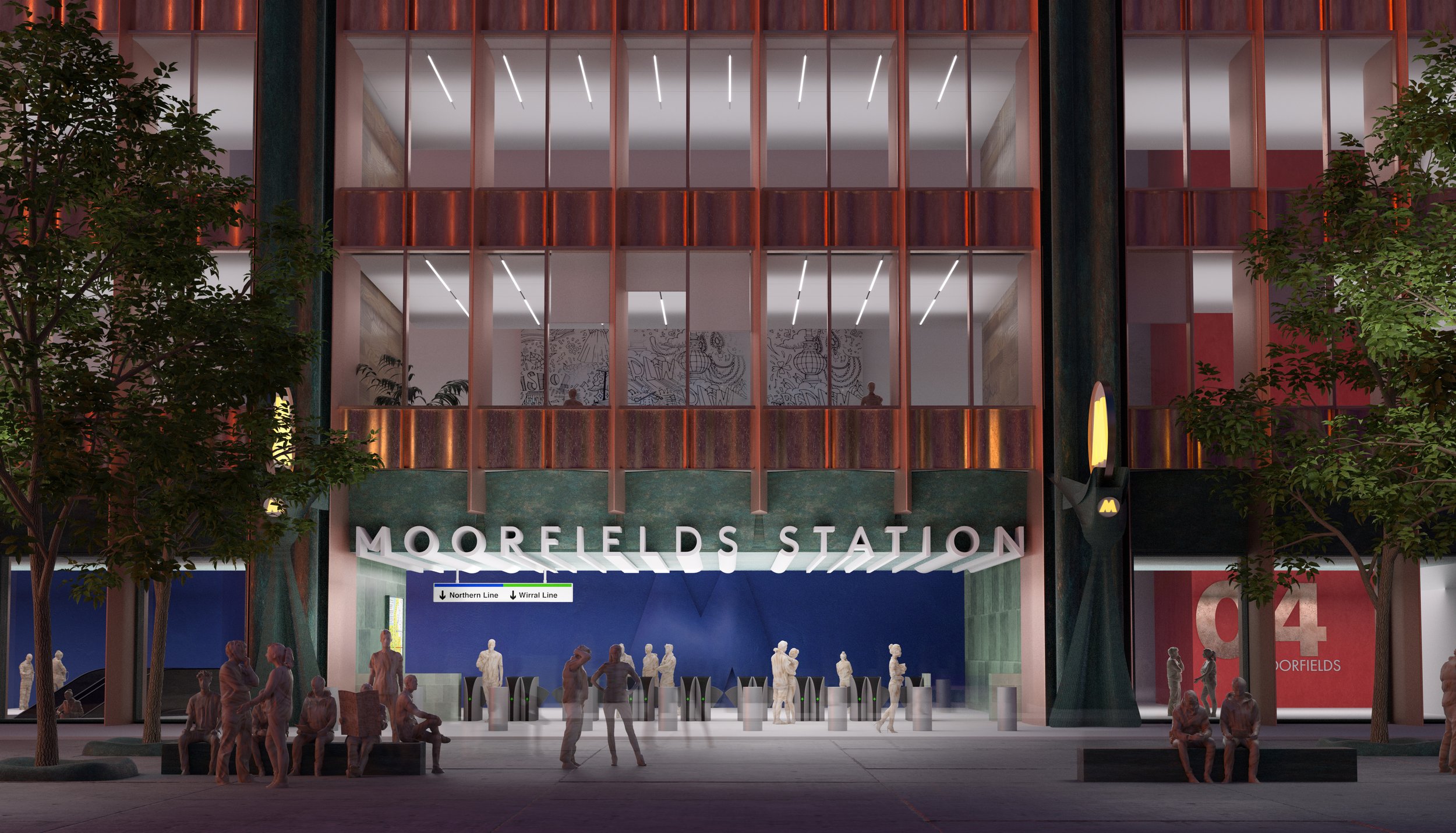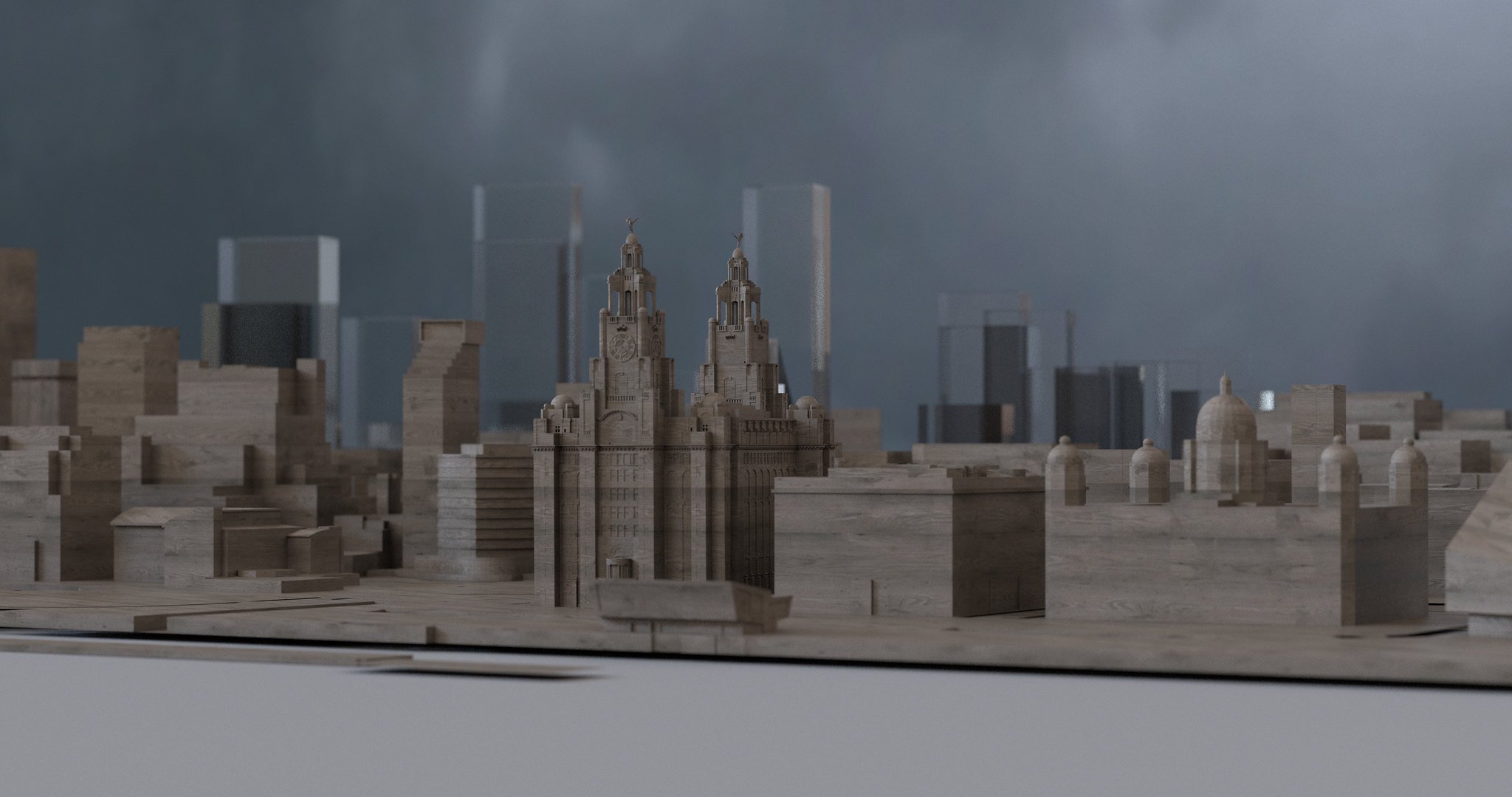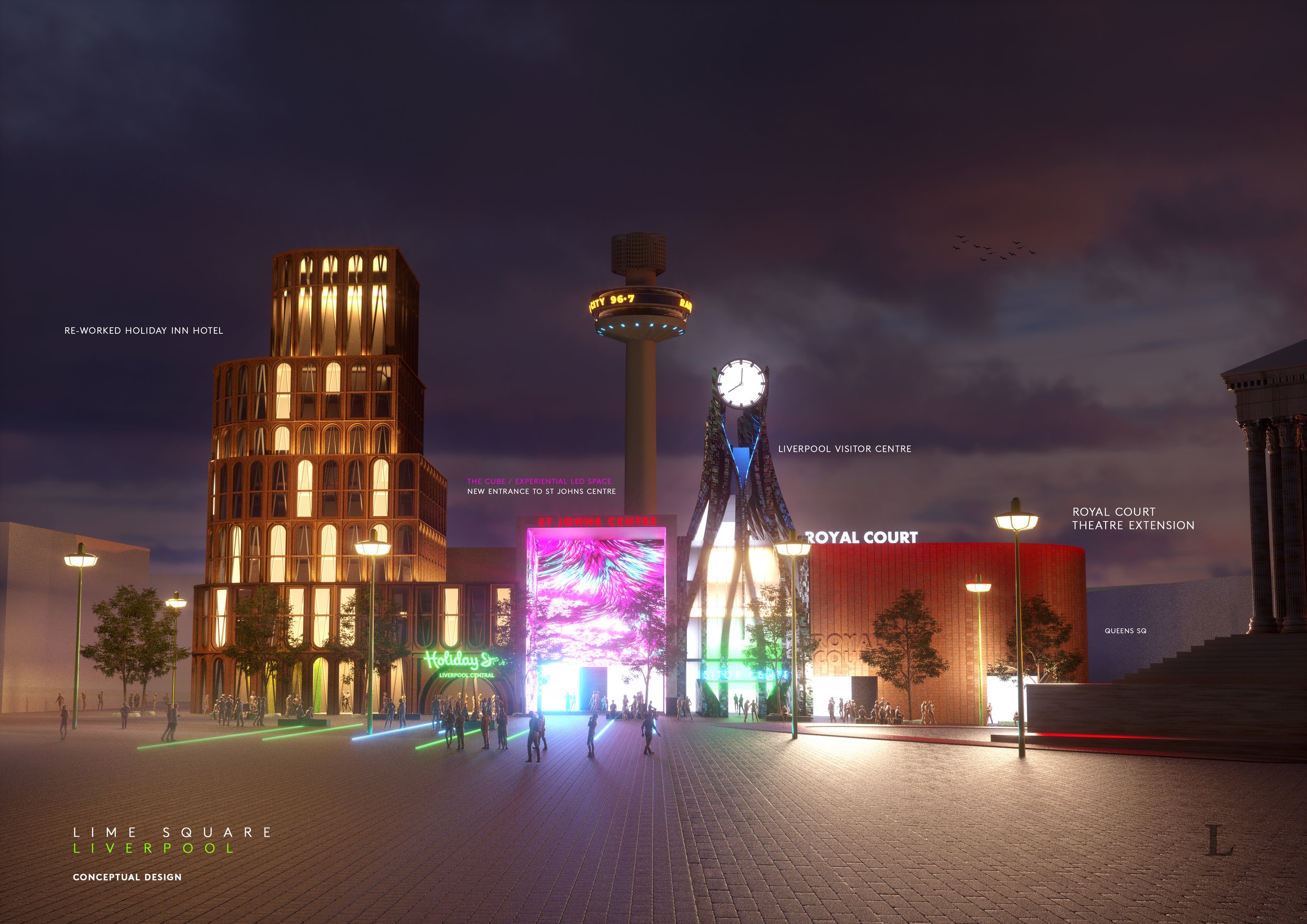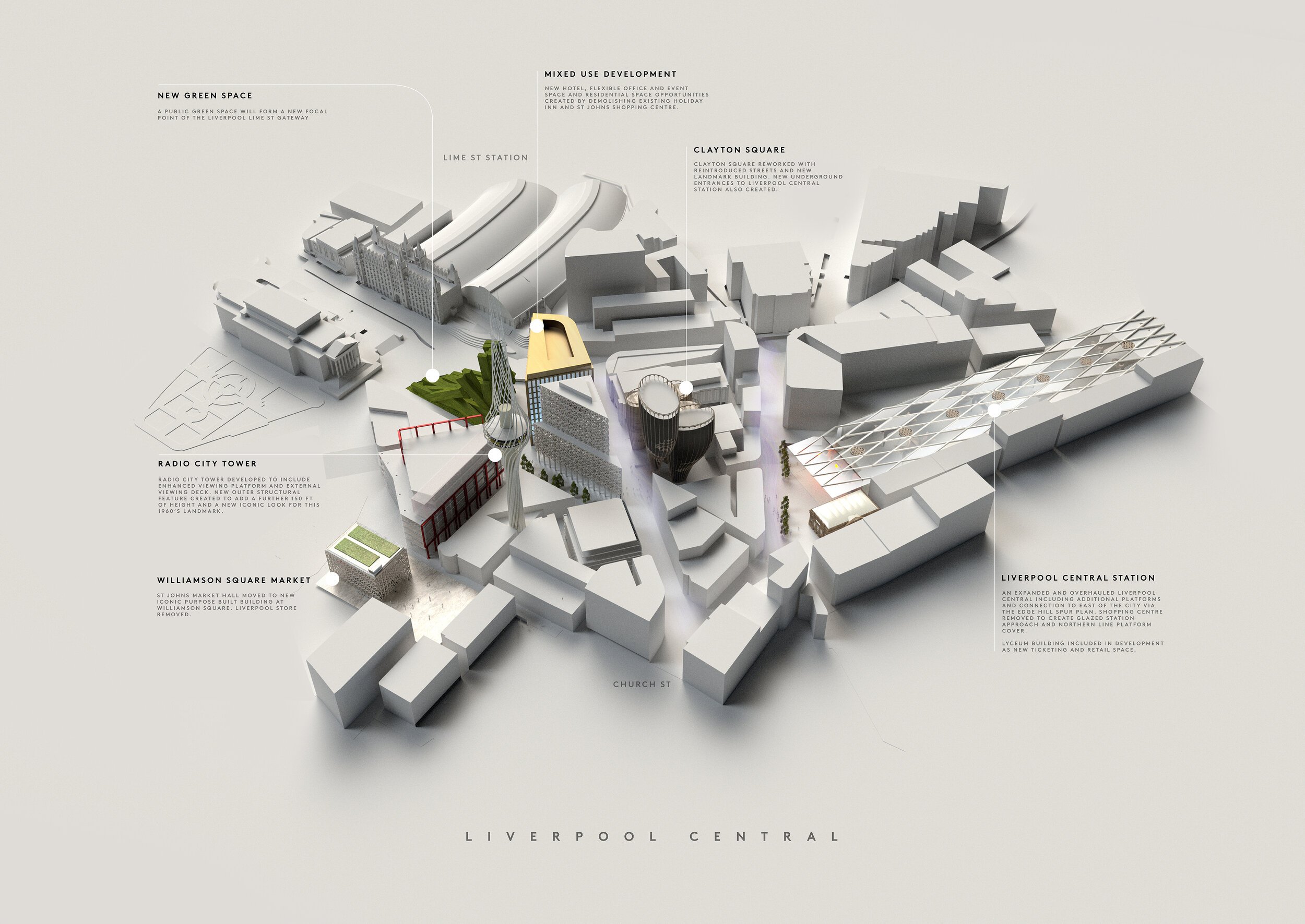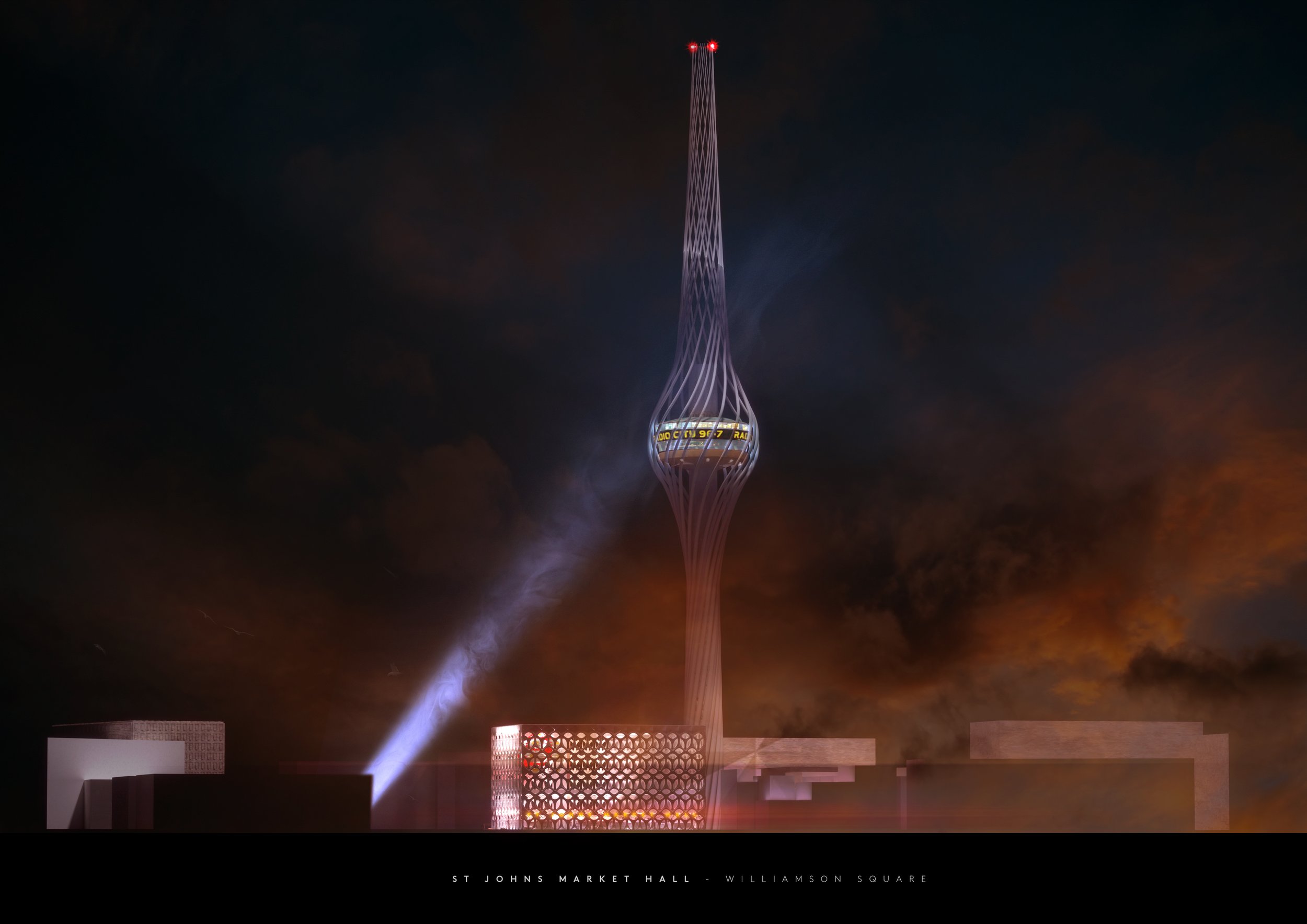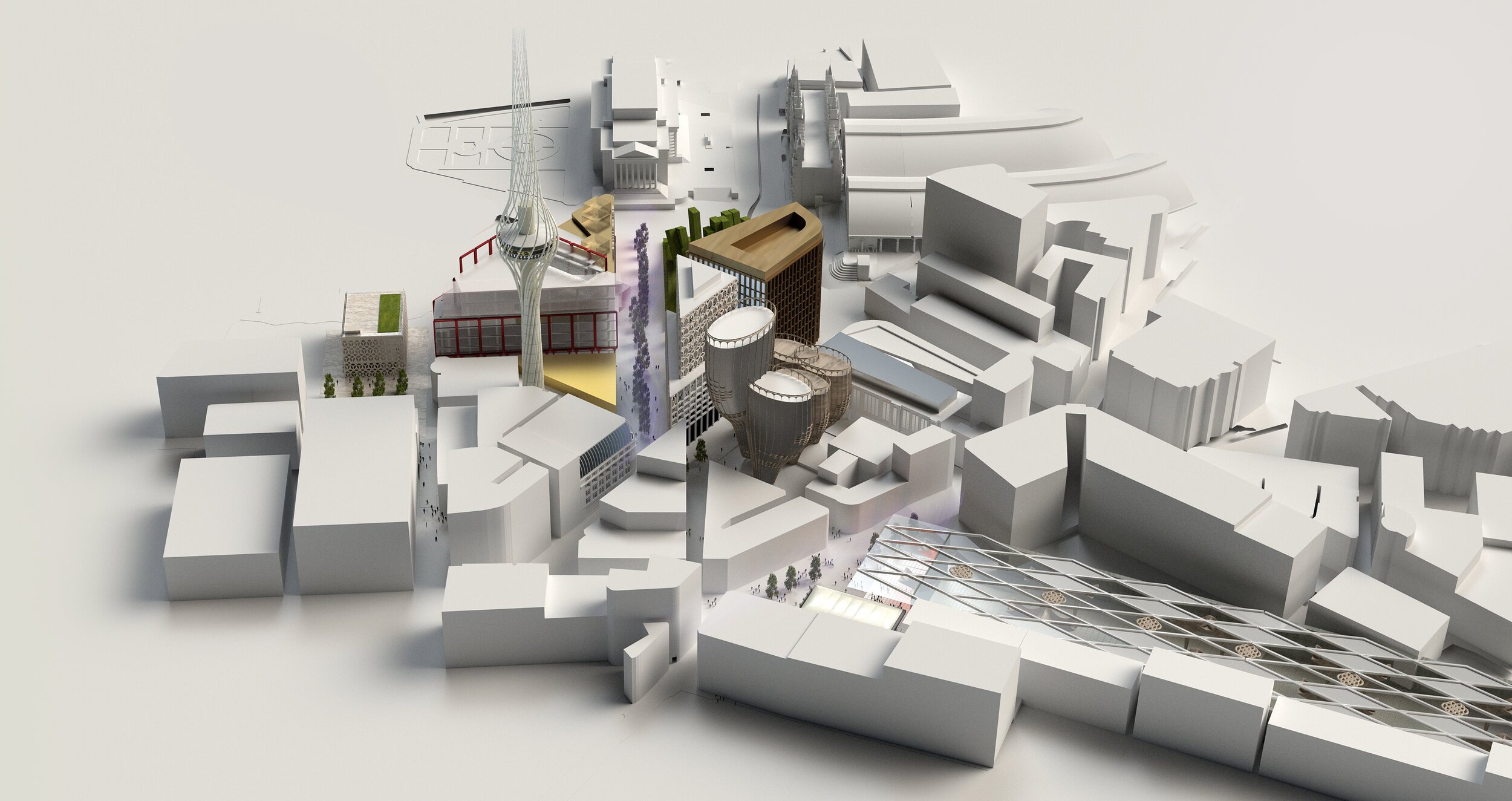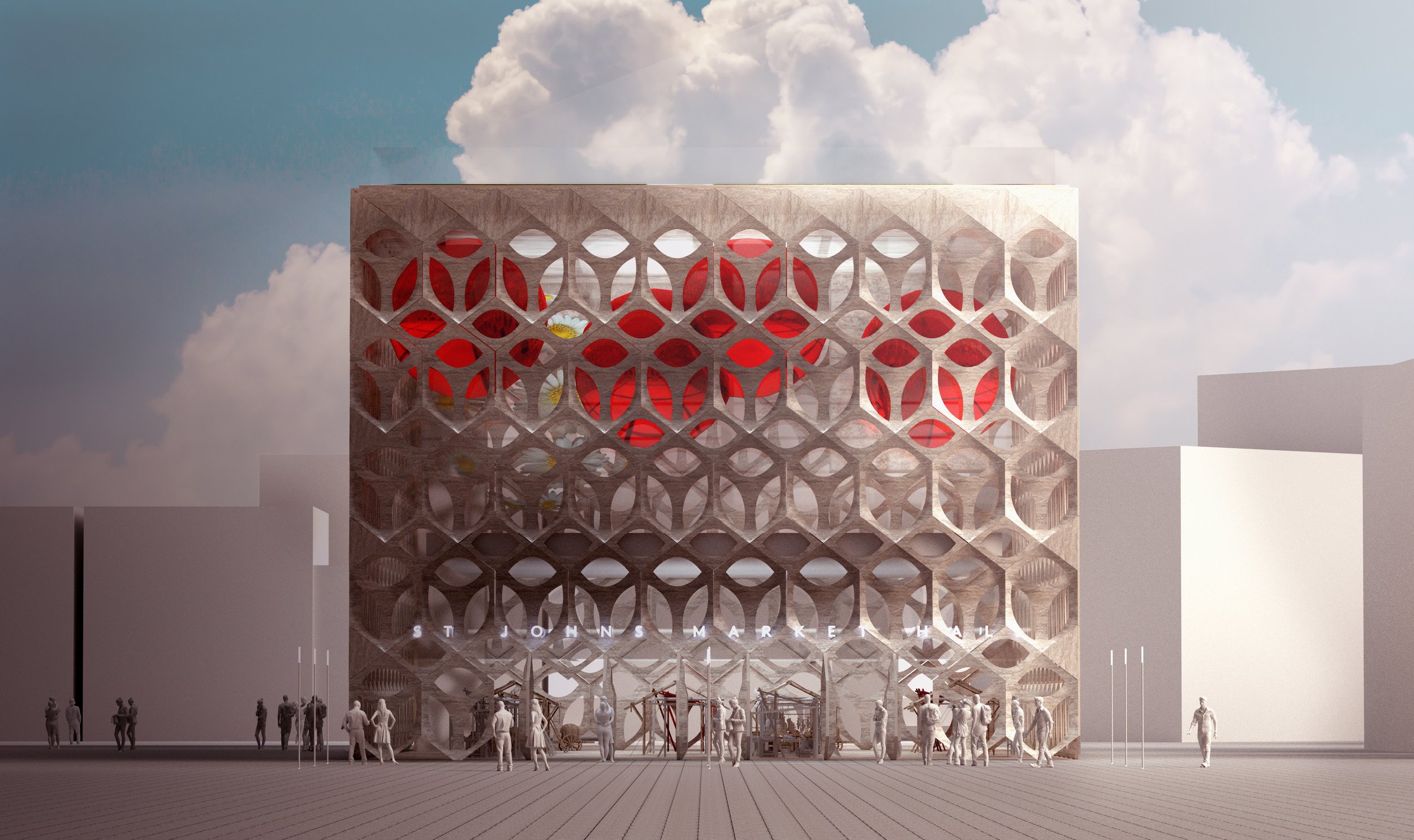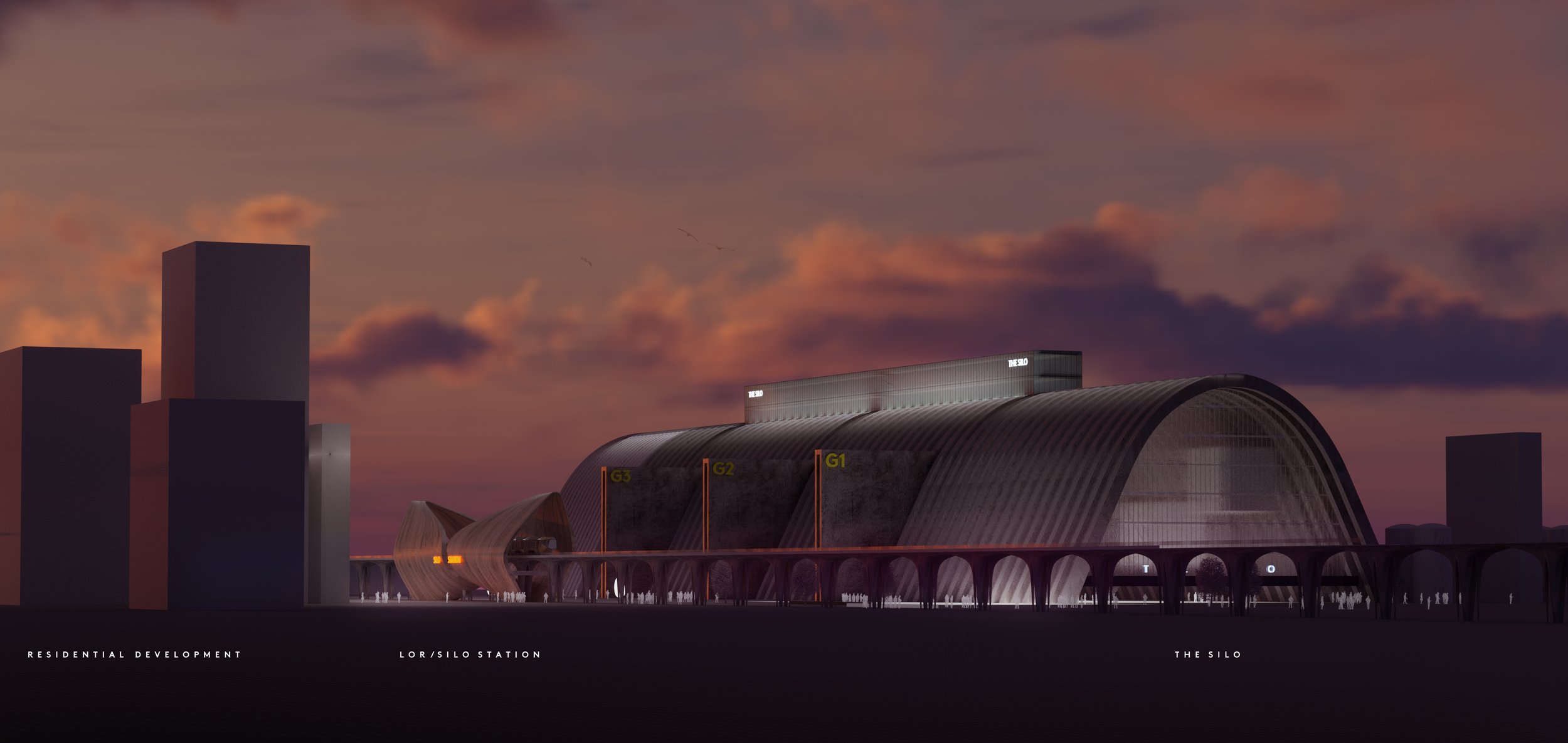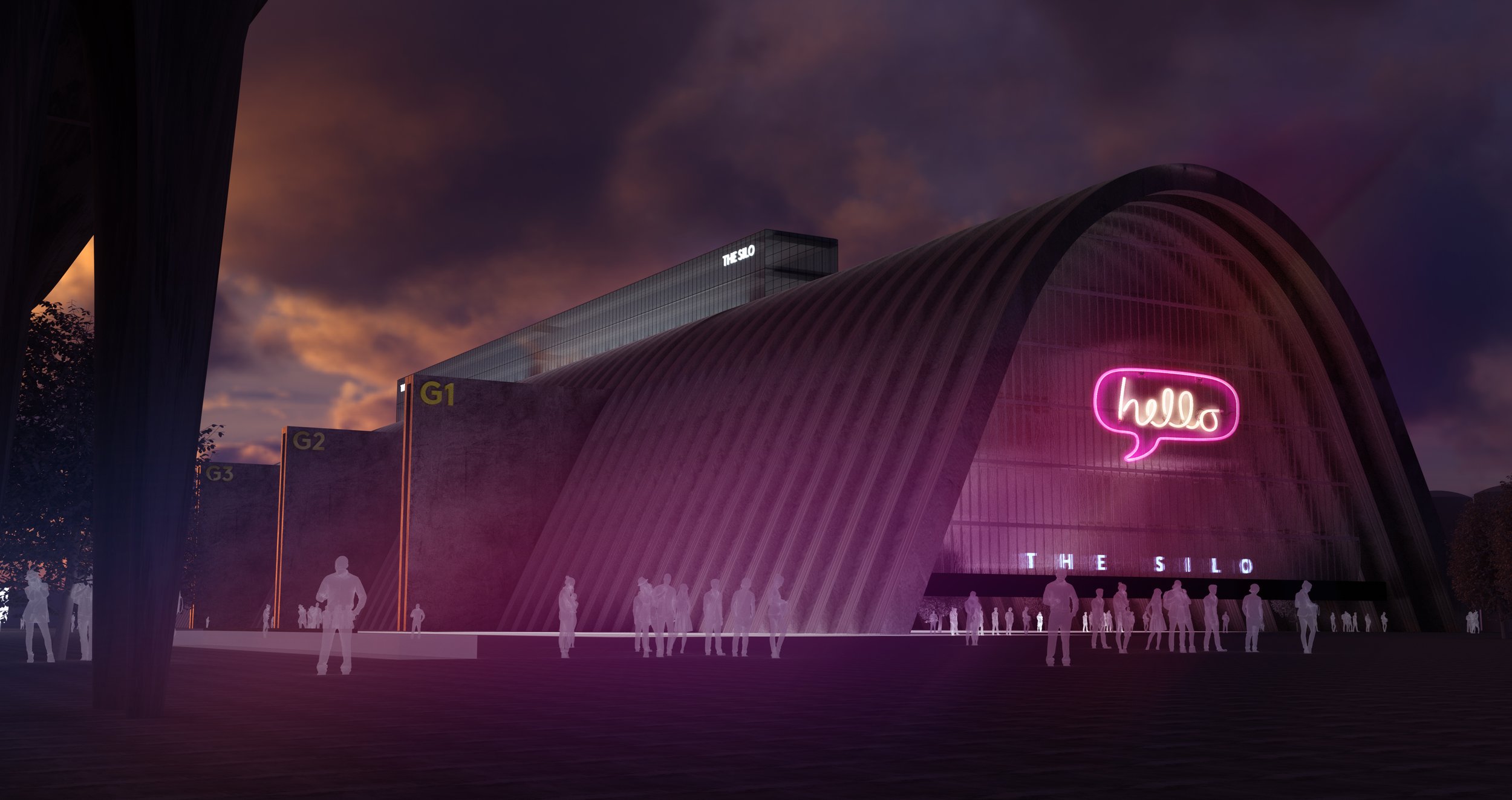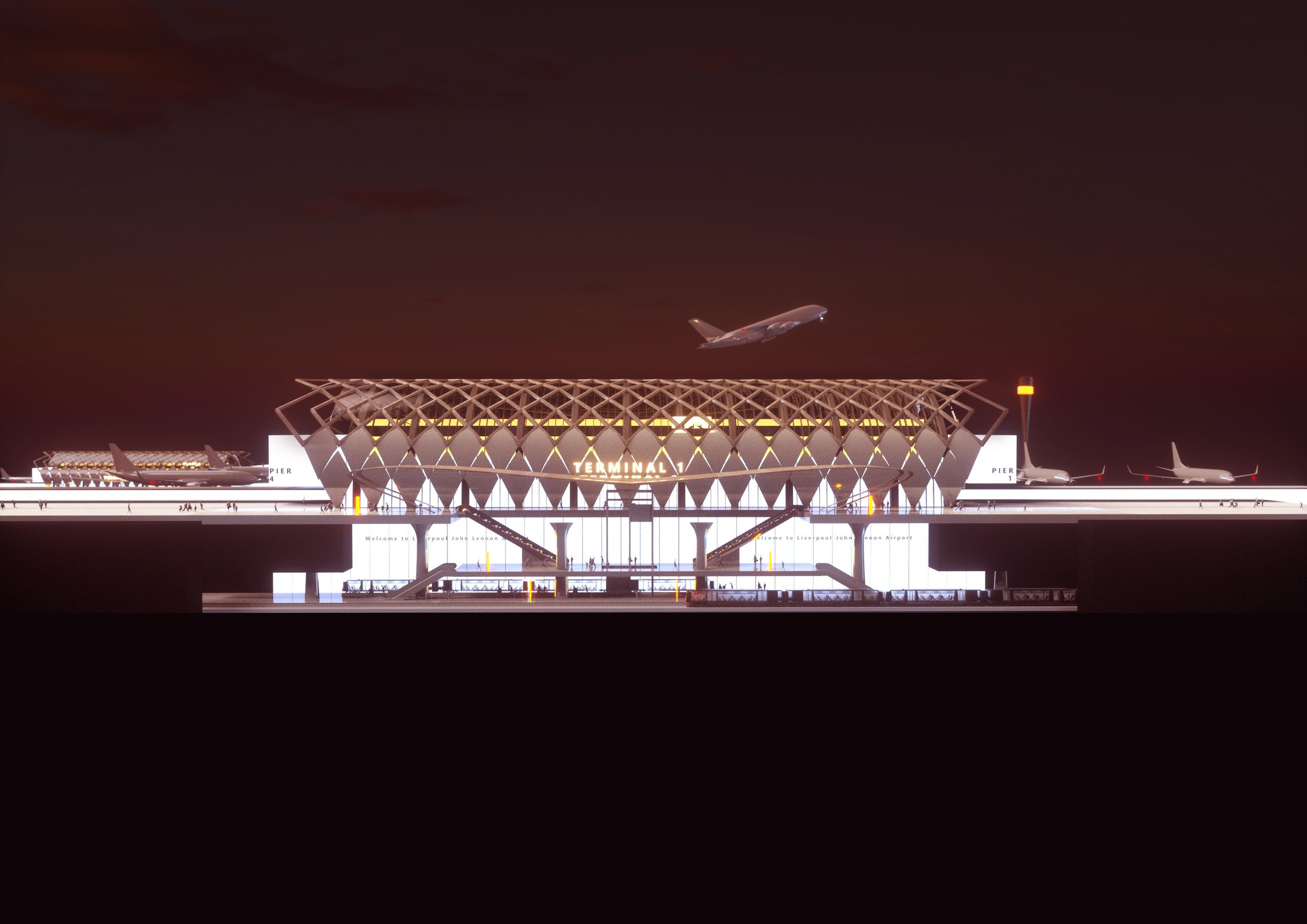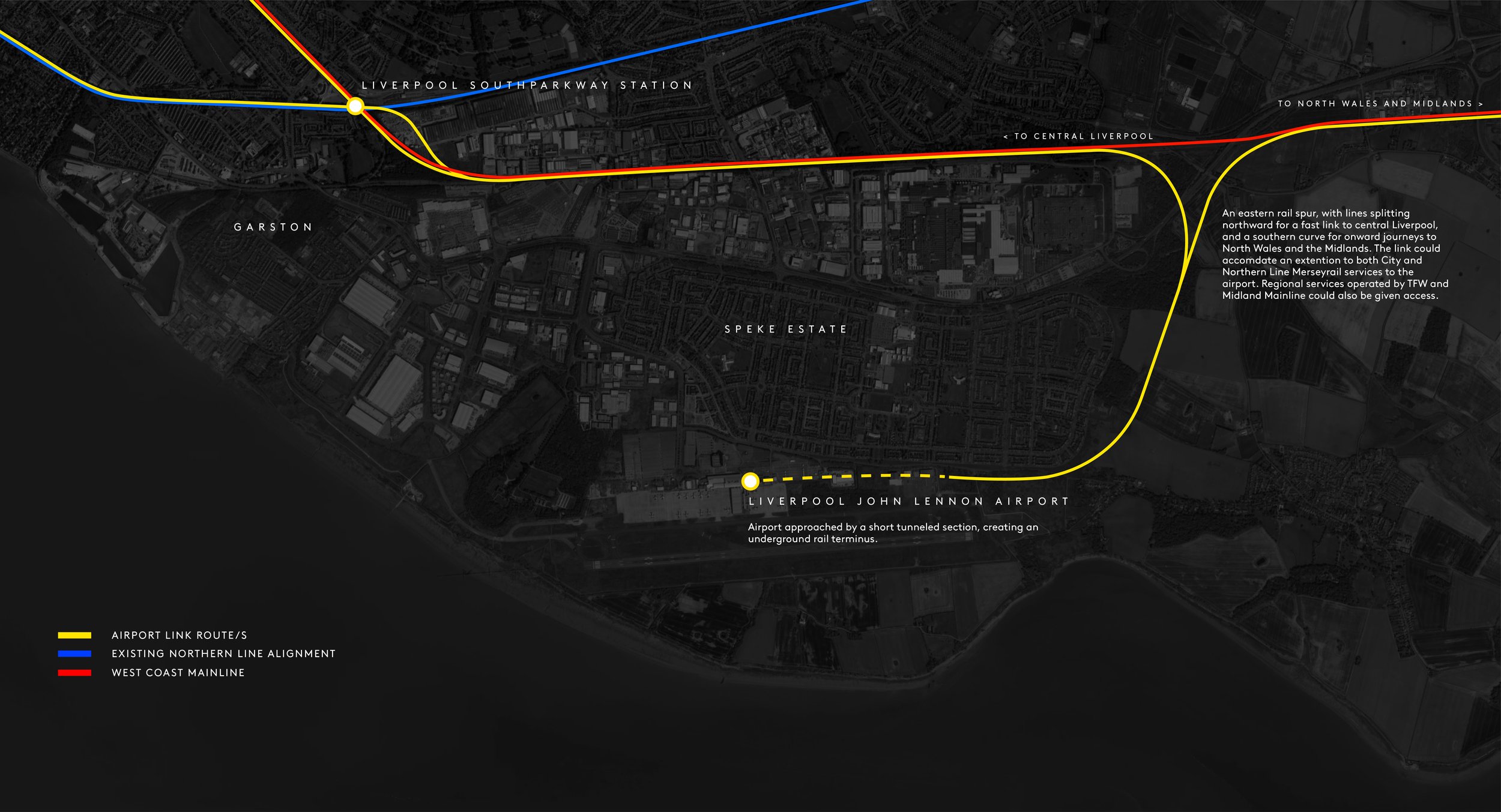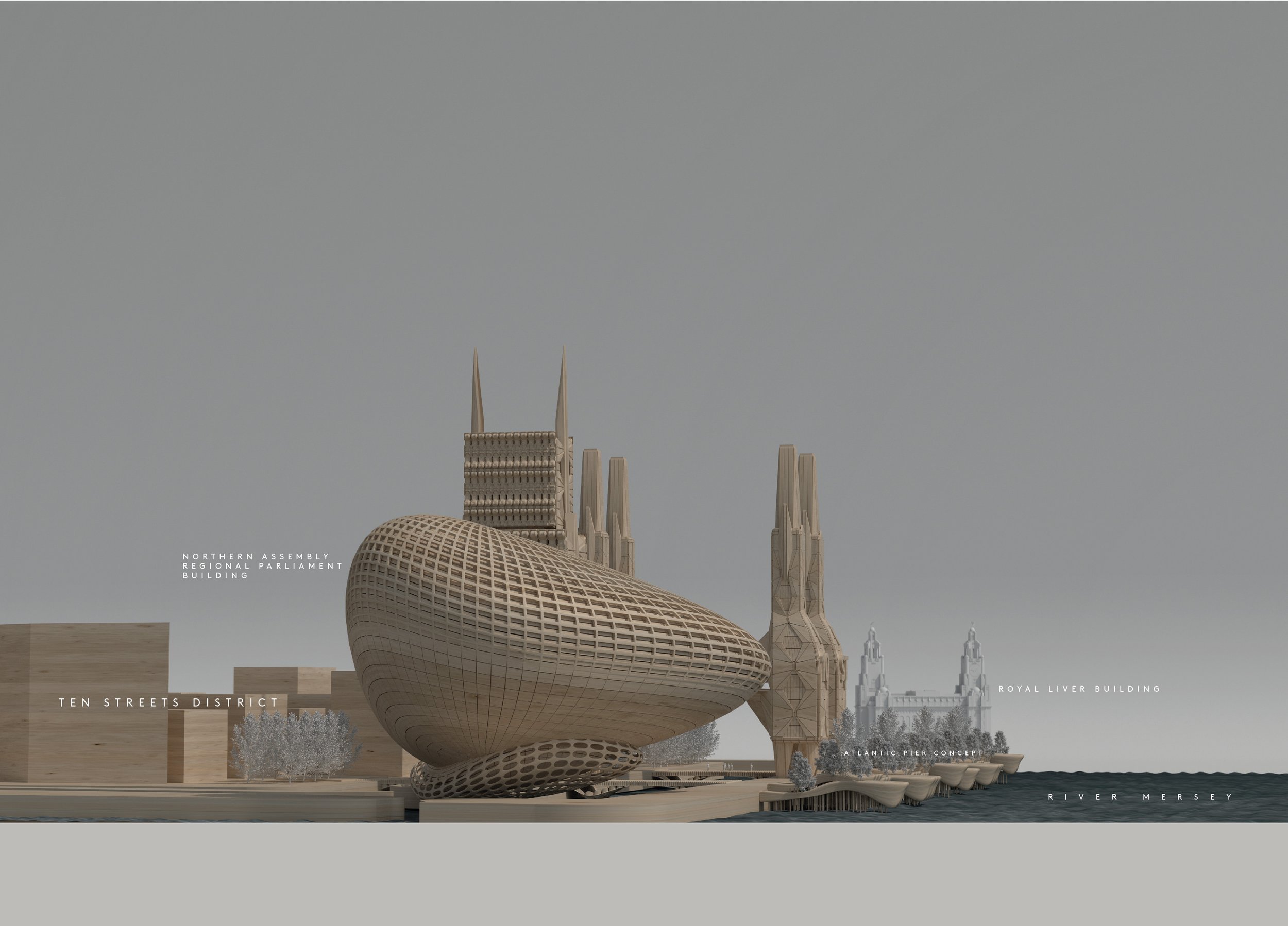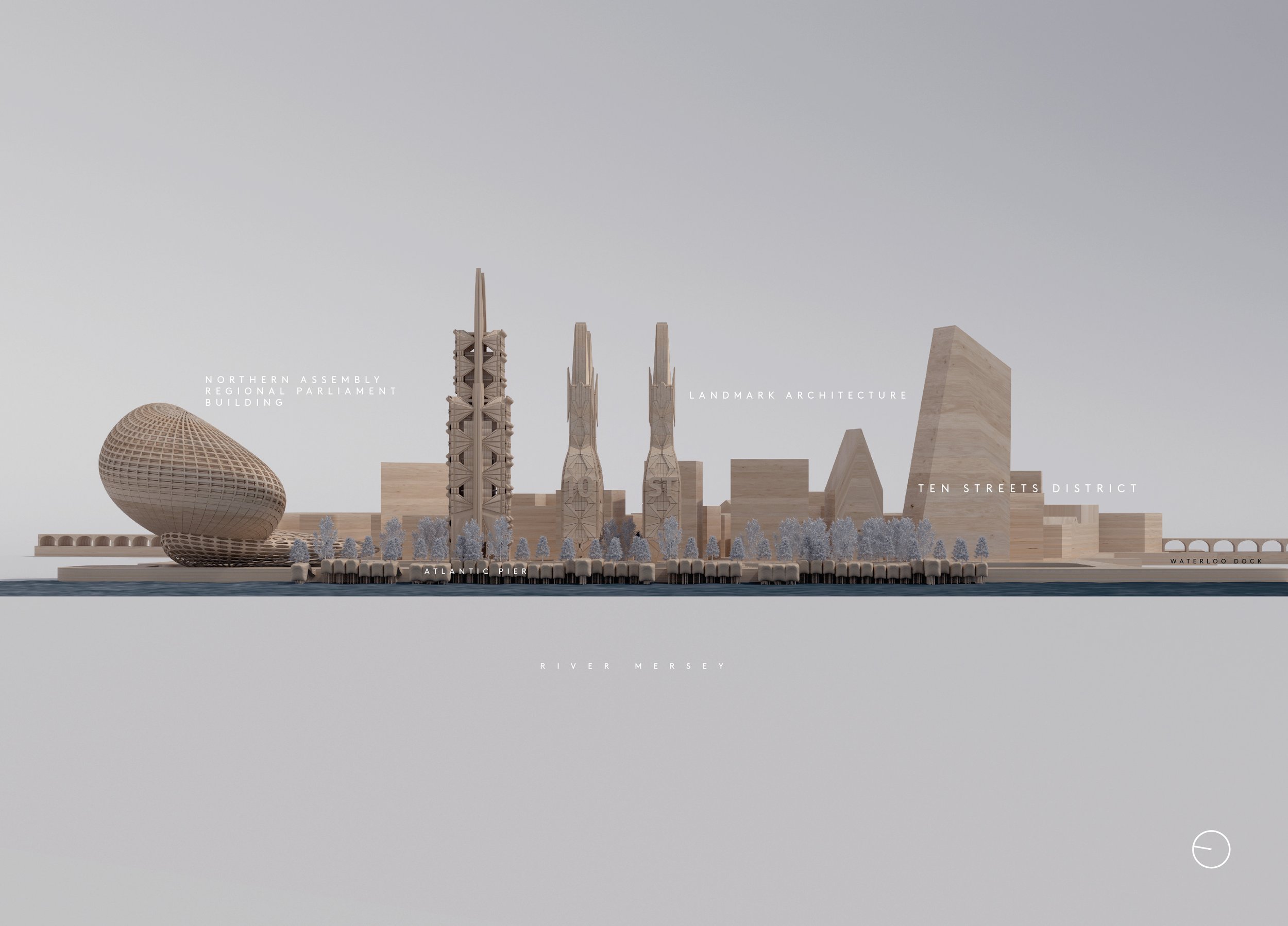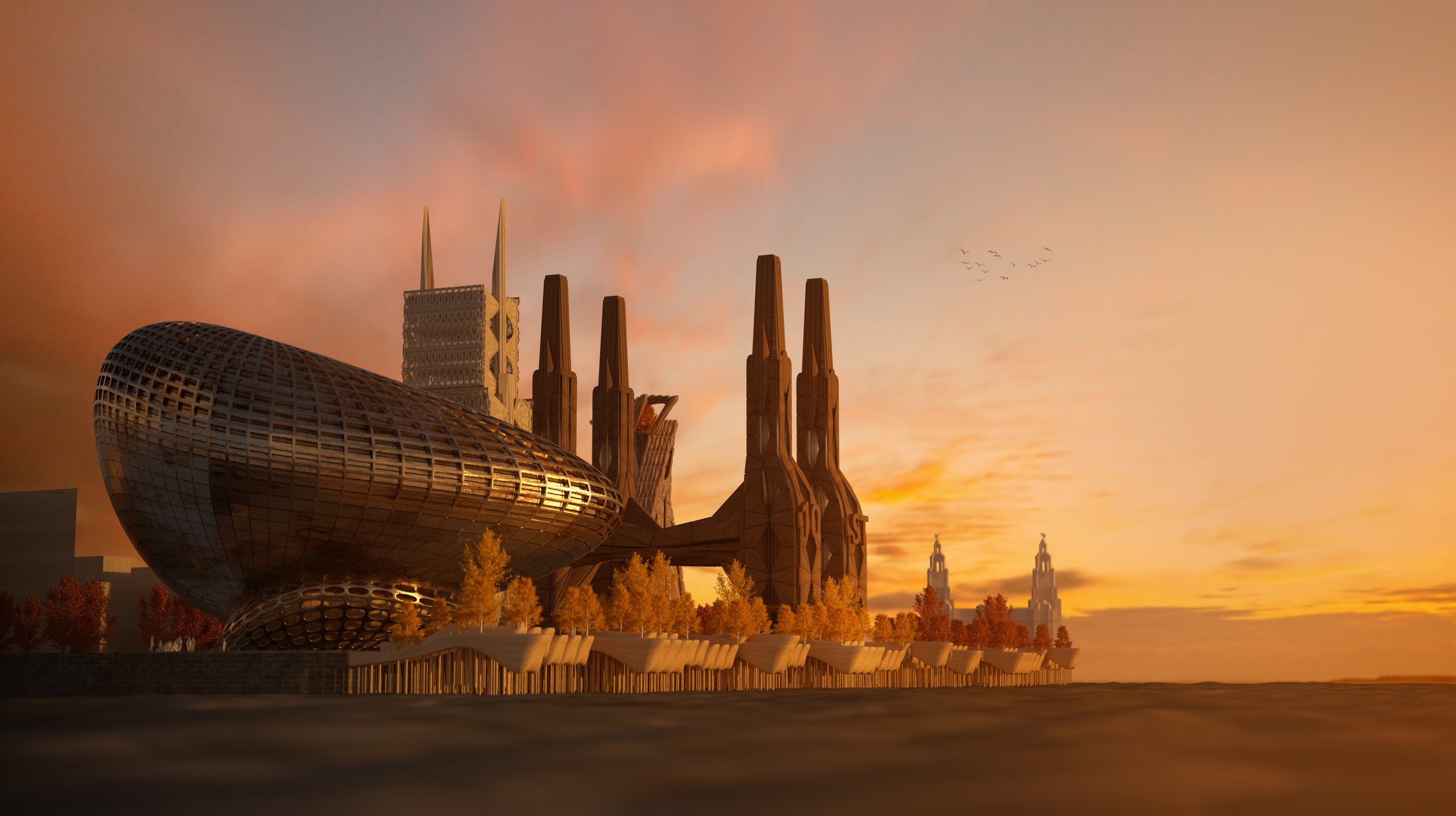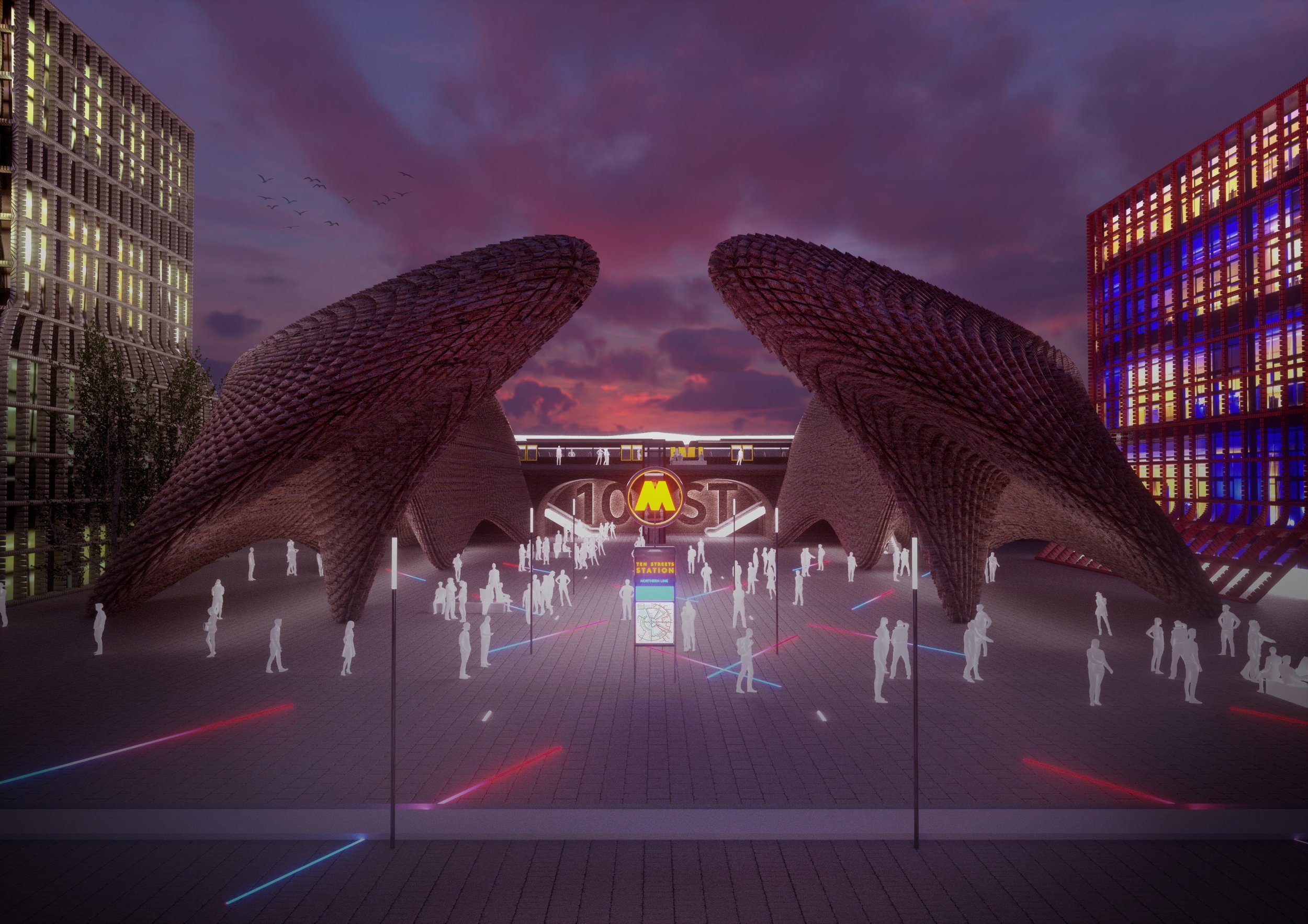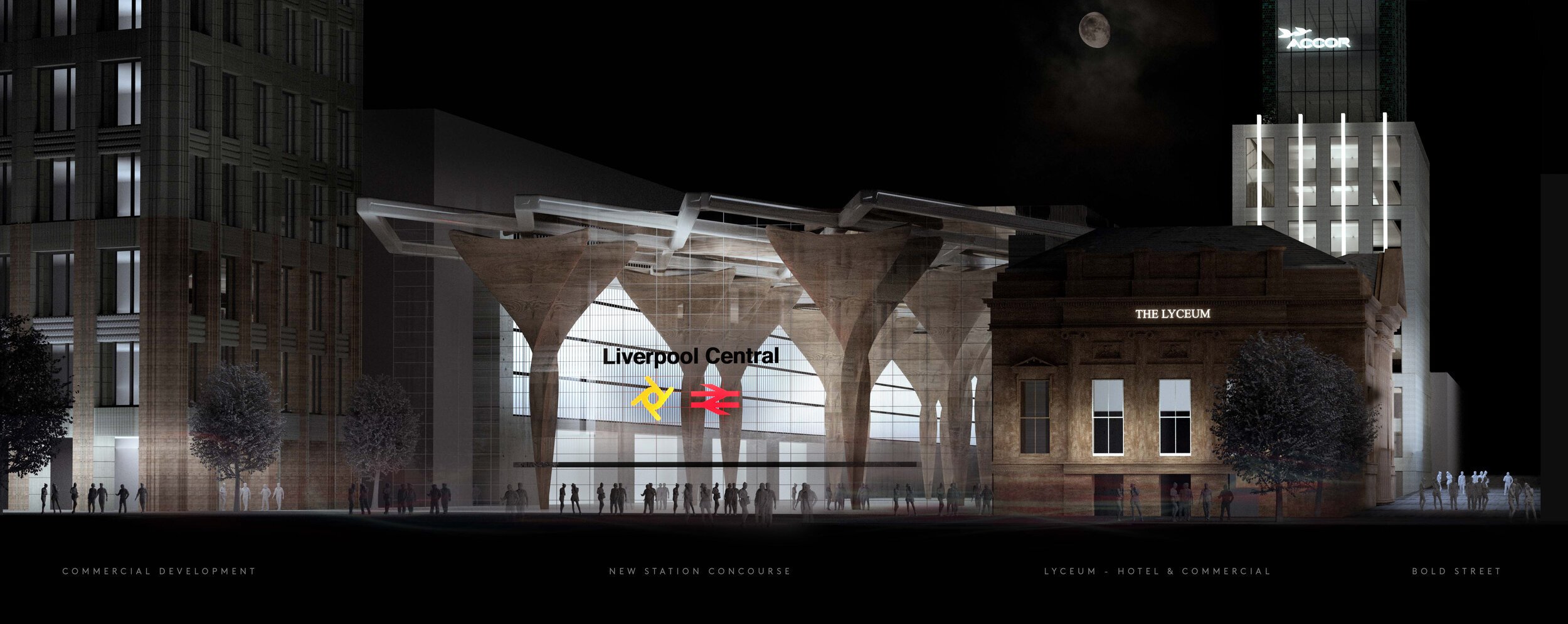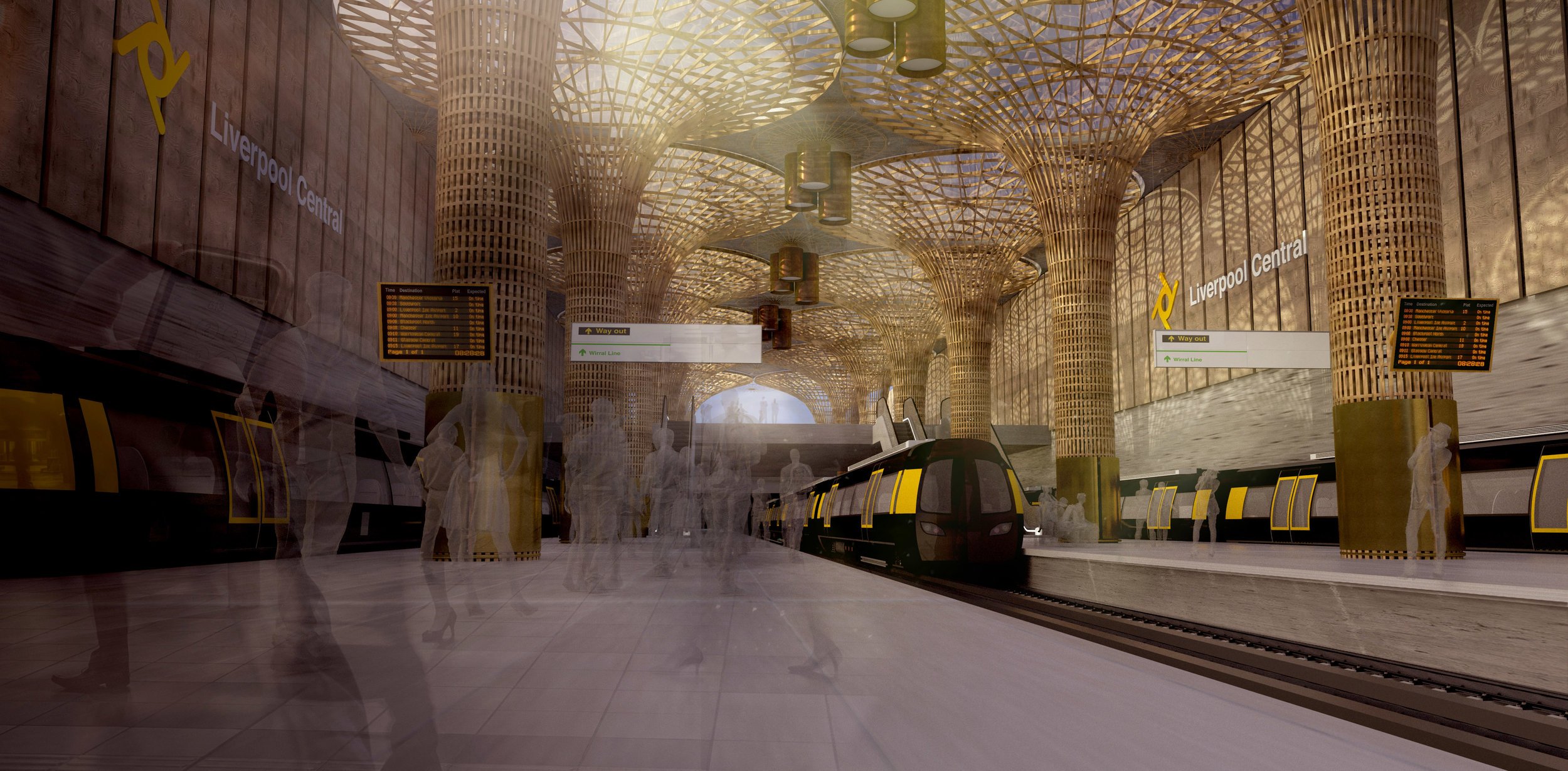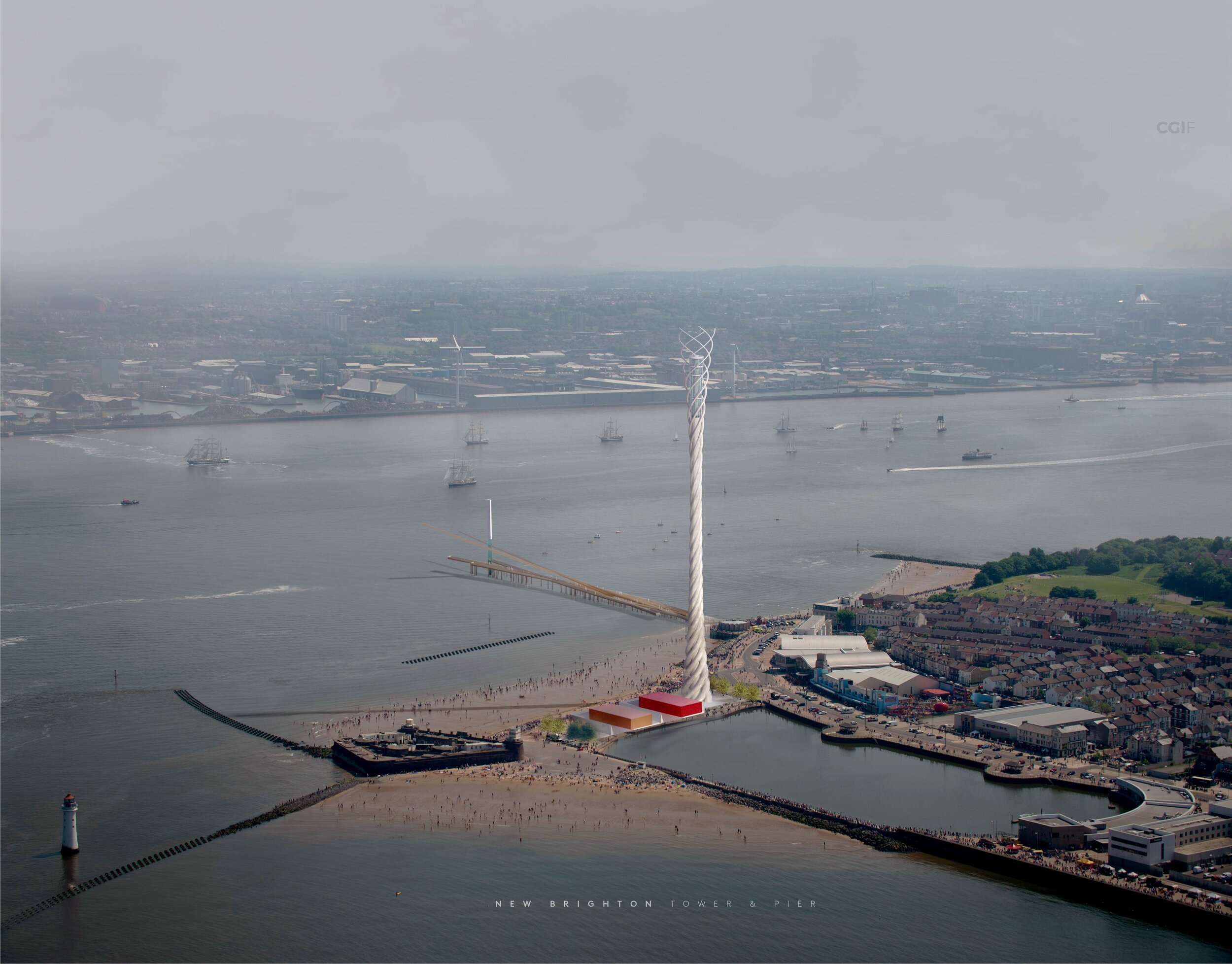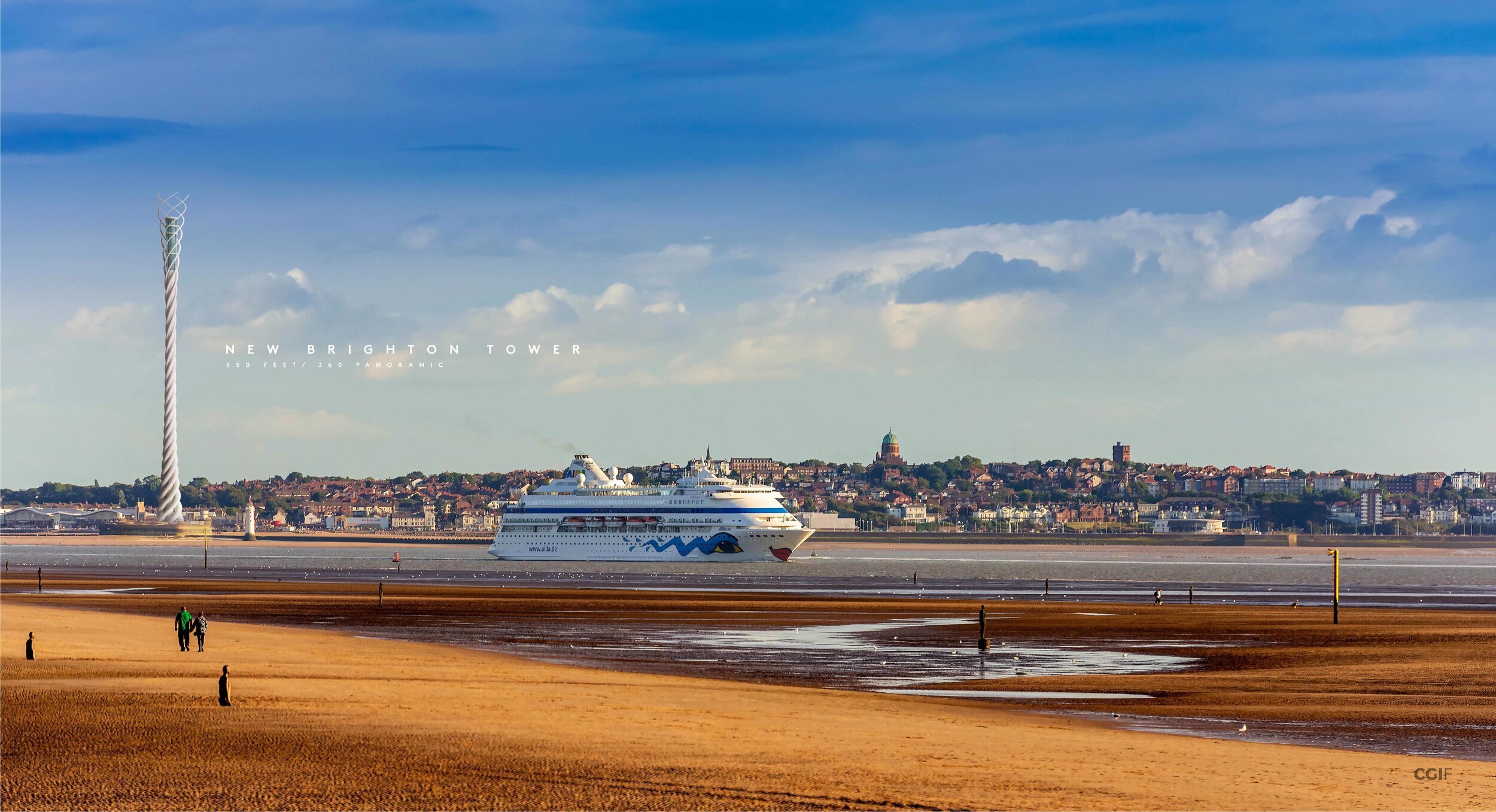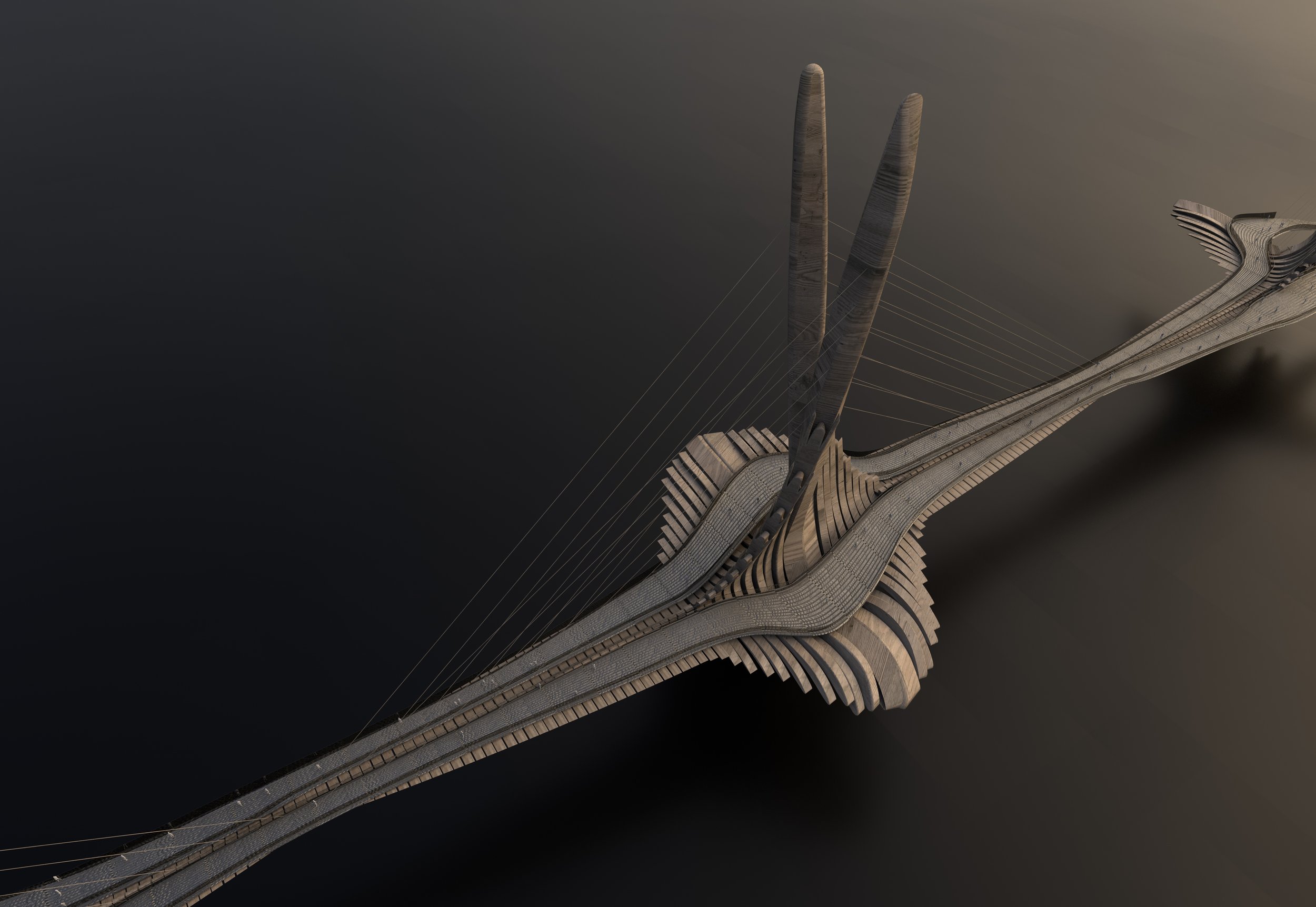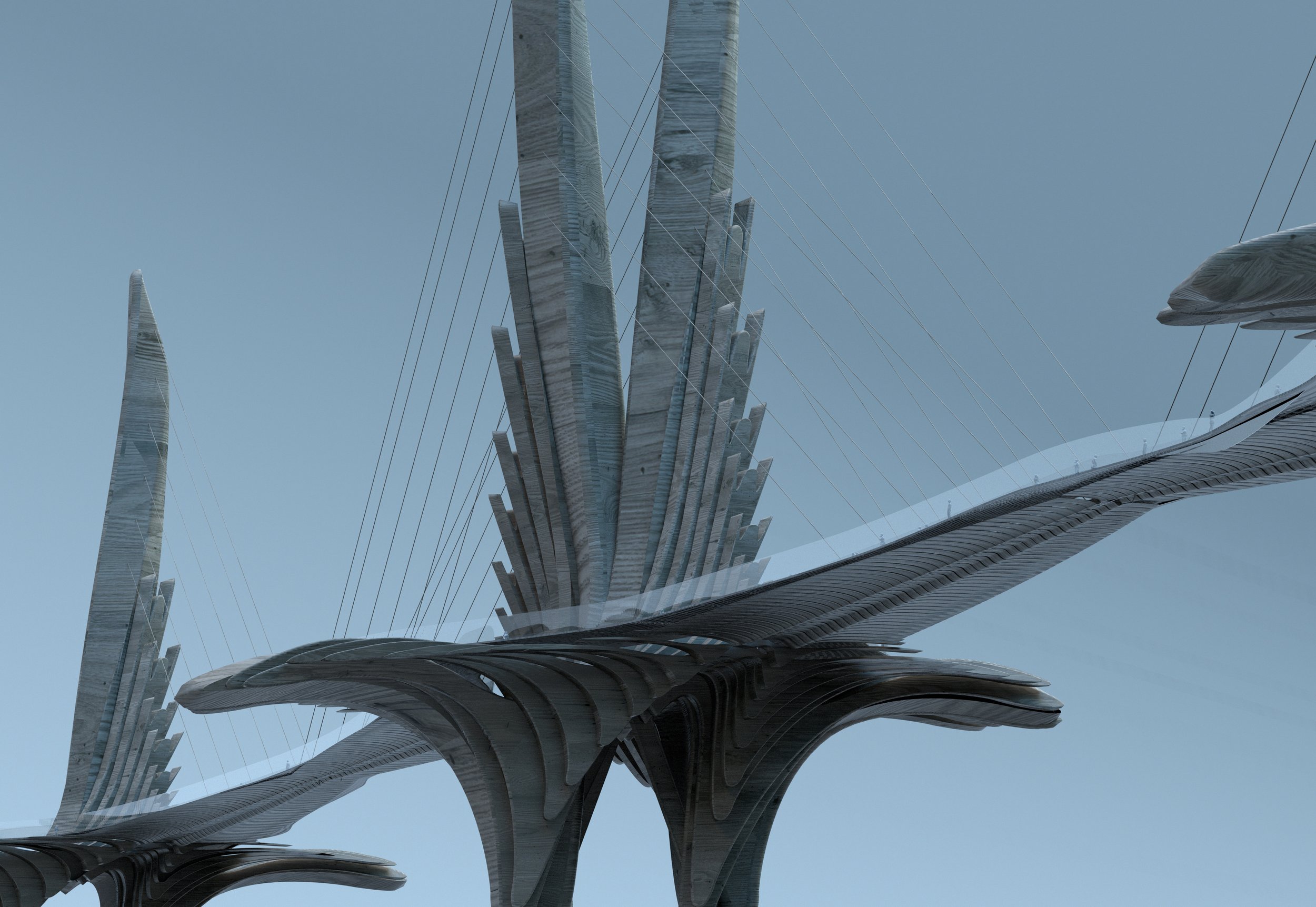Recent features
Ye Wha? Opera on the Mersey and other Mad Visions
For over ten years, 3D animator Michael McDonough, has been dreaming up new ways to re-imagine Liverpool’s urban landscape – designing outlandish opera houses, cathedral-like train stations, gothic bridges, and new visions for the docks. None of them have been built or are ever likely to be. But why does he bother? In this showcase of his work, Liverpolitan Editor, Paul Bryan explores Michael’s fascinating dreamscapes of the imagination.
Paul Bryan
“The way I come at things is to make no small plans. The city has had too much of that, too much dross, too much crap, too much small time thinking.”
So says Michael McDonough, Co-Founder here at Liverpolitan, and a man who has developed a bit of a reputation for his outspoken criticism of Liverpool’s (lack of) development scene. And in fairness, it’s a view that I, as the magazine’s Editor, often share.
One of the things that makes Michael interesting to me (other than the fact he’s had to develop skin as thick as a rhinosaurus to bat off ‘the army of gobshites’ who take him on or even pose as him online) is the fact that despite a successful career as a 3D designer and animator which has taken him to the capital, he continues through his design work to try to make a positive contribution to his home city of Liverpool and the discussion about its future. He does this without fanfare or gratitude and in fact, often in the face of quite complacent criticism from ‘locals’. Often by people with far less talent or insight than himself. For over ten years now, entirely under his own steam, Michael has been dreaming up new ways to re-imagine Liverpool’s urban landscape – designing outlandish opera houses, cathedral-like train stations, gothic bridges, and new visions for the docks. None of them have been built or are ever likely to be. They are not fully formed architectural plans, more dreamscapes of the imagination and we’ve made a showcase of that work in this feature article.
But why does he bother? What’s the point? Aren’t they just castles in the air built before AI and Midjourney made fantastical images the prerogative of all? To believe so would be to miss what’s really going on. There’s a much harder edge lying beneath the glossy visuals. He’s making the case for ambition as an antidote to a city-wide loss of nerve.
“We should be thinking in the same way world cities do like London, Singapore and New York. All these places have big ambitions. We should be looking to emulate that,” says McDonough. Instead, he believes Liverpool increasingly seems resigned to a lower status and too often its mediocre plans reflect that. Small schemes are favoured over transformative ones and then heralded as being the way forward. Anything substantial or showy is typically treated with hostility and suspicion.
“I keep hearing that in Liverpool we’re different, that we have our own models of success, but it’s a language of defeatism, masked and airbrushed as some kind of urban superiority.” He rejects this idea totally. “Being different doesn’t mean you reject ambition, scale and big ideas. That doesn’t make you different, it just makes you stupid.”
‘There’s an obsession in Liverpool’s planning circles with ‘context’ – the idea that new developments must be submissive to the city’s crown jewels."
Michael’s designs are meant in sharp contrast to the veritable cottage industry of ‘place-making’ peddlers, much favoured in recent years by our city leaders, whose low aspiration output chimes with this defeatist mindset. Meanwhile, the same old local architectural practices win job after job, churning out budget off-the-shelf buildings that further erode what makes the city special. There’s an obsession in Liverpool’s planning circles with ‘context’ – the idea that new developments must be submissive to the city’s crown jewels. But that attitude just results in bad buildings and Michael’s designs deliberately shun such restrictions. Some of his designs will inspire, but also enrage.
“The irony,” says McDonough, “is that those buildings we love so much are there purely because of ambition, because of power and commerce. They didn’t just land there as gifts from God.”
The point of history is to learn from it, not to fetishize it. We do Liverpool’s history a disservice by feeble attempts at mimicry. The Liverpool of yesteryear was bolder and more global in its perspective and if we are to take something useful from the past, it should be that. What Michael is attempting to do with these designs is to remind the city that it’s capable of bigger ideas, capable of re-imagining itself, capable of statement architecture, and capable of challenging its city rivals.
“What pushes me to create these designs is a desire to make people see the city differently – and by that I mean primarily the people who live and work within it. Because if we can awaken that boldness of old, so much is possible in our future,” says Michael. That is the lens through which he’d like people to view his designs. Of course, design is subjective. What might be considered beautiful by one person, can be viewed as horrendous by another but he claims to welcome those reactions. “One of our motivations for founding Liverpolitan magazine, was to create a place where thoughts and ideas on the city’s built environment could be shared, discussed and visualised – to think beyond self-constrained limitations,” he concludes. And indeed that is part of our mission.
So buckle in. This is Michael’s contribution. We hope others will be inspired to contribute in the future. It’s a long read. You may need a cup of tea. But there are lots of pretty pictures and food for thought.
Enjoy.
English National Opera, Liverpool
Post-Eurovision, Liverpool emerges with its reputation for hosting big events enhanced and attention inevitably turns to ‘what next?’ So how should the city attempt to capitalise on this positive exposure? Capitalise being the key word here – turning the benefits of a one-off event into something long-lasting, and preferably given a tangible physical form.
Step forward candidate 1: The English National Opera (ENO). This prestigious London-based institution has been told by its funders, Arts Council England, that if it wants the purse strings to remain untied, the institution needs to up-sticks and move to the regions, and rumour has it that Liverpool is very much on the short-list. Some will question why a city like Liverpool needs opera, but even if Tosca and Turandot are not your kind of thing, attracting such a high profile organisation will only add to Liverpool’s cultural offer and open up new job opportunities for young people who might otherwise fly the nest.
Dreaming up a new opera house on the banks of the Mersey, is something that dates back to the wild and unfunded dreams of former Mayor Joe Anderson. But this time, at least in theory, the prospect sounds a little more plausible. Not fully plausible mind – a recent article in The Post claimed the move might be more northern outpost than wholesale relocation, akin to Channel 4’s setup in Leeds. Still, it’s not completely out of the equation – especially if a new facility could combine uses with other functions – education, meeting space, performance arts. Back in 2021, the then-chancellor, Rishi Sunak allocated £2m for a feasibility study into some kind of new immersive music attraction. So despite initial talk of yet another Beatles-focused space, perhaps there’s scope for blending these projects onto one site to make the whole more achievable.
‘The point of history is to learn from it, not to fetishize it. We do Liverpool’s history a disservice by feeble attempts at mimicry.’
The most obvious location is the site of the now defunct former police station headquarters at Canning Place off the Strand. It’s a big site in a glamorous location with the potential to integrate the city centre more closely with the Baltic Triangle. In scale, Michael is proposing a building similar to the much lauded Copenhagen Opera House, which also has a waterfront setting, but he’s keen to avoid any slavish adherence to ‘context’ – “the space is big enough to create its own”, adding new aesthetic design cues to Liverpool’s urban environment rather than forever replicating (usually in impoverished form) what is already there. For Michael, this means “no warehouse-style blocks, no red-brick, and a departure from straight lines.” Some have said they can see a cobra snake in this design and others an elephant (hopefully not of the white variety). “I didn’t intend either but if they’re there, they’re there,” says Michael. “It’s all about organic, smooth, natural forms.” The final two images in the set, which show the interior of the main auditorium, were created using artificial intelligence more as an experiment in what is possible with the technology.
As an added bonus, Michael is proposing to demolish the John Lewis car park, which adds a “blocky barrier to the growth of the city centre eastwards,” as well as eroding the sense of occasion that this landmark structure deserves. A new solution would have to be found for the bus depot that sits beneath it (not to be confused with the Paradise Street Bus Station which would remain unaffected).




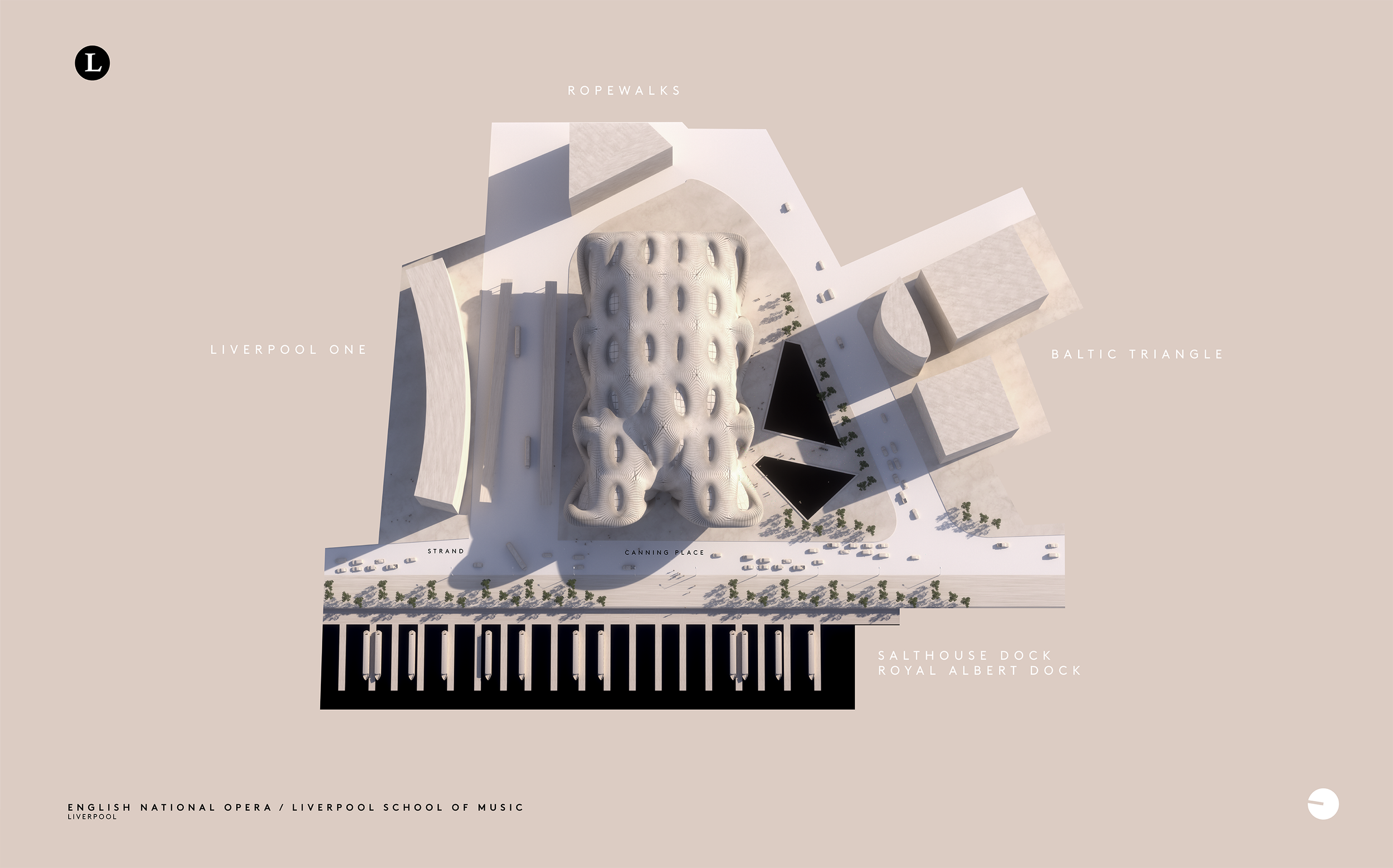
Liverpool Overhead Railway
Many people have long been fascinated by the Liverpool Overhead railway and perplexed by its loss. Extending seven miles along the length of the city’s impressive docklands from Seaforth and Litherland in the north to the Dingle in the south, the line survived for just 64 years before the decline in dock employment ate too deeply into its commuter base. There can be little doubt that if the Overhead Railway had survived into the modern era instead of being dismantled in 1956-57, it would have become another iconic symbol of Liverpool reminiscent of the Chicago ‘L’ trains. Not only that, but it may have long ago expedited the regeneration of the north docks into other uses. Instead, minus viable transport provision, we have had to watch on powerless as docks have lain derelict for decades under the tattered banner of Liverpool Waters.
As much as it’s fun to sit within an old Overhead carriage within the Liverpool Museum (and marvel at its spacious dimensions and varnished wooden interiors), Michael would much prefer to see it rebuilt. The case is becoming stronger with the soon to open Bramley Moore Dock Stadium, the Titanic Hotel and new apartments in the Tobacco warehouse extending the city centre and creating a line of activity to the attractions centred around the Albert Dock.
‘The Liverpool Overhead Railway may have long ago expedited the regeneration of the north docks into other uses. Instead, minus viable transport provision, we have had to watch on powerless as docks have lain derelict for decades under the tattered banner of Liverpool Waters.’
However, Michael says “we cannot and should not merely recreate a pastiche of the old line.” Technology and engineering have moved on, and the old structure was difficult and expensive to maintain. Besides, its heavy-set viaducts blocked views of the river from further inland, which might be unwelcome today. If the city are ever to rebuild the Liverpool Overhead Railway, he feels it should “celebrate the past but not be beholden to it.” A little like London’s Docklands Light Railway (DLR), his version 2.0 is a fully-fledged railway, not a monorail, elevated by organic and elegant concrete columns that avoid the blocky and very nineties form of the DLR design.
To maximise its utility, Michael’s new Liverpool Overhead Railway would not simply follow the old route but would connect more widely. Starting at Bootle in the north to better integrate that area as part of our metropolis, the line would connect the Everton stadium and key attractions centred around the Albert Dock before heading off south to the airport, and perhaps also east via the disused Waterloo or Victoria tunnels. The design of the structure would be modern, and the trains capable of running on conventional tracks (like the recently introduced Merseyrail ones) opening up options for integration with the wider rail network.
Royal Opera House North & Wirral Cultural Centre
At Liverpolitan, we’ve always believed the Wirral Waterfront to be Liverpool’s great missed opportunity. Overlooking one of the finest riverside vistas in the world, the left bank of the Mersey should be prime real estate, and yet it’s almost apologetically unimpressive – as if frightened to upstage its more famous brother. Surely, we can do better? “People laughed at the idea of Salford Quays hosting the BBC and the Imperial War Museum North,” says Michael, “but with its spectacular setting, the Wirral Waterfront should be aiming higher again.”
Two waterfronts, one city has to be the future but to really make that idea count, at some point we’ll need a significant intervention in the landscape. Wirral Council are doing good work in master planning a new Birkenhead with a better relationship to the river and Liverpolitan is all for it. But to seal the deal, argues Michael, “the Wirral needs something that stands out, something that can be seen from the Liverpool side – something that says ‘Look at me, come over to the Left Bank.’”
Given the 0.7 mile width of the Mersey between Liverpool and Birkenhead, any new landmark structure would need to be huge, gargantuan even. Taller than the 210 feet Ventilation Tower. Possibly taller than the 328 feet Radio City Tower. Cathedral-like in scale and presence. It was along those lines that McDonough put forward this earlier concept for a Royal Opera House North – aligned so that “you can see it as you look down Water Street – the two sides of the river visually connected with an iconic landmark; a catalyst for seeing Birkenhead through new eyes.”
The design is dominated by a series of steel funnels with a glinting chrome façade pointing in all directions of the compass including skyward. They would be wrapped around a central auditorium which could also have uses as a cultural centre exploring the Wirral’s fascinating history from the Vikings to its use as a monastic retreat, not to mention shipbuilding and its colourful background as a smugglers paradise.
‘The Wirral needs something that stands out, something that can be seen from the Liverpool side – that says ‘Look at me, come over to the Left Bank.’
Liverpool HS2
It’s all gone a bit quiet on the High Speed 2 railway project hasn’t it? Maybe that’s a good thing – just get on and build it. But for Liverpolitan, HS2 has always been something of a poker-tell, not so much about the lack of commitment of the national government to invest anywhere outside of the south – which to be honest, we can all take for granted. No, what HS2 really reveals in full technicolour is the shallowness of Northern solidarity – some places, most notably Manchester and Leeds are consistently favoured over others like Liverpool and Newcastle. Despite the sweet words of ‘King of the North’, Andy Burnham, arguments about agglomeration are forever used to draw money and opportunity towards these investment blackholes and away from everywhere else. And HS2 has been the smoking gun. More’s the pity that Liverpool’s own leaders have been too foolish to notice (or they never cared).
When the Conservative government announced the Integrated Rail Plan for the North and Midlands in late 2021, the media was full of a wailing and gnashing of teeth. Cutting HS2’s eastern leg to Leeds and scaling back plans for Northern Powerhouse Rail was seen as more evidence of the perfidiousness of London and Whitehall. Right on cue, Liverpool’s often hapless Metro Major Steve Rotheram, joined in the venting, complaining that “we were promised Grand Designs, but we’ve had to settle for 60 Minute Make Over.”
Not for the first time, a fair reflection of Liverpool’s own particular interests was absent, but with the help of railway campaigners like Martin Sloman and Andrew Morris of 20 Miles More, Liverpolitan spotted it. The truth was, the plan might have been less good for Leeds and Manchester but it was better for Liverpool. Fresh high speed track was going to be laid closer to the city in a dedicated spur that would relieve capacity constraints and increase the scope for an expansion in freight services. In addition, the need to widen the narrow throat entrance to Lime Street was also finally acknowledged. Hurrah!
‘What HS2 really reveals in full technicolour is the shallowness of Northern solidarity – some places, most notably Manchester and Leeds are consistently favoured over others like Liverpool and Newcastle.’
Still, wanting the best for Liverpool means building new track all the way into the city centre serviced by a full specification HS2 station. By the way, what happened to the commission set up by Steve Rotheram in March 2019 and announced with full fanfare at the MIPIM Property Exhibition, which chaired by Everton CEO Denise Barrett-Baxendale, was going to choose between 2 possible locations for a new “architecturally stunning” HS2 station in the city centre as well as 5 routes in for the track? Quietly dropped?
Focusing on the most likely outcome of a redeveloped Liverpool Lime Street, Michael has put together some outline designs, which incorporated the grade-II listed Radisson Red Hotel (previously the North Western Hotel) as the main entrance to the station.
To read Liverpolitan’s cutting dissection of HS2 and the Integrated Rail Plan for the North and Midlands, check out ‘HS2 – A Liverpool Coup?’ by Michael McDonough and Paul Bryan
Or to read Martin Sloman’s examination into the options for a city centre station, try ‘Lime Street or Bust? The Options For Liverpool’s HS2 Station’
Moorfields and the Commercial District
Back in March 2023, Liverpolitan tweeted about the state of Moorfields, which we described as “a regrettable symbol of Liverpool's down at heel CBD.” We noted that the area is littered with dereliction, empty office buildings and signs of homelessness, and asked the question, “Have we become so used to this embarrassing patch that we no longer see it as failure?”
The tweet received almost 45,000 views and provoked a whole host of online conversation with the issue later picked up by the Liverpool Echo. Councillor Nick Small, who after the recent local elections is now the city’s Cabinet Member For Growth and the Economy, got involved, agreeing that the site needs to be developed. There was some discussion about whether robust plans for the area were in place already as part of the City Centre Local Plan and Strategic Investment Frameworks (SIFs). But mostly, to the extent that the local BID or the Council have acknowledged the issue, action on the ground seems in short supply.
To some extent, the lack of regeneration may be an issue of plot owners sitting on parcels of land and waiting for a payday, but as a subsequent squabble between Merseyrail and the Council over who was responsible for cleaning the grotty Moorfields escalator showed, a lack of concerted coordination between agencies leaves ample scope for things to fall between the cracks.
Moorfields is littered with dereliction, empty office buildings and signs of homelessness. Have we become so used to this embarrassing patch that we no longer see it as failure?
Michael McDonough argues that Moorfields is another of Liverpool’s great missed opportunities and it’s hard to disagree. The area’s city centre location, great transport links, and historic setting within the traditional heart of Liverpool commerce, should with the right support, allow it to live again. “The whole area needs re-invention and the drift towards noisy bars and tourism serves to cheapen its prospects,” says Michael. He claims that demolishing the rotten Yates Wine Lodge should just be the start. “Moorfields can handle density and scale and is the perfect place to rebuild Liverpool’s grade-A office offer” centred around the idea of prestige and talent.
In these visuals, Michael wanted to rebuild the entrance to Moorfields Station with mid-rise commercial office space above – no more going up to go down. He also took a stab at upgrading the former Exchange Station offices, which “may have been grand from the front, but from the rear leave a lot to be desired” – failing to properly address the park that will hopefully one day be re-instated as part of new public realm within the wider Pall Mall development.
St Johns and Central Liverpool
Far, far and away McDonough’s biggest bugbear with Liverpool’s built environment has to the St Johns Shopping Centre. We know it’s commercially successful and last time we looked it had a 97% retail occupancy rate. It clearly fills an important niche within the city’s shopping offer with its cheaper rents for retailers. But damn if isn’t an ugly pig of a building (no offence to our porcine brethren). Arriving at Liverpool Lime Street, that’s the first thing you see. Talk about first impressions. Squatting over a network of old streets and the site of what would be today, if it hadn’t been bulldozed, a much valued Victorian market, Michael believes St Johns is a “dated lump of a building that acts as a physical and psychological barrier between London Road and the rest of the city centre.” It’s not a stretch to suggest that St Johns has played a role in the former’s decline. Repeated, half-hearted attempts to patch the shopping centre up have failed and its blue plastic blanket and struggling traders’ market are a testament to “a succession of bad planning decisions going back fifty plus years.” A lasting solution to all of these problems, says Michael, “requires demolition.”
The images Michael has put together here are a collection of different attempts to reinvent this “ugly and misfiring section of Liverpool.” The main driving force behind his designs is a desire to remove this “lumpen barrier” and re-stitch together our centre “in a more permeable way that evokes expressions of pride rather than cringes.” Michael wants to see a much better front door to Liverpool Lime Street – our city’s once grand hello and goodbye point. He’d like to replace this “parody of the city’s greatness” with something more iconic and ambitious.
‘St Johns is a dated lump of a building, its blue plastic blanket and struggling traders’ market a testament to a succession of bad planning decisions going back fifty plus years.’
The eagle-eyed might spot the use of neon and a prominent clock tower as a modernised callback to what the site has lost. As Michael says, “we can’t always recreate the past but we can be inspired by its best bits.” He’s also given the Grade 2-listed but still a bit ugly, Radio City Tower, a makeover, adding an elegant polished steel lattice of radiating lines which add height, fluidity and tricks of light to recast a regional landmark into one of world significance.
Read more about Michael McDonough’s vision for St Johns in the Liverpolitan feature, A New Central Liverpool.
The Silo
The former grain silo in the north docks is one of Liverpolitan’s favourite buildings in Liverpool. If it was just a little further south, closer to the Tobacco warehouse and Bramley Moore, we could imagine it being repurposed as a truly iconic, high capacity arts, events and business hub. However, the silo is located deep within the working part of the dock estate with industrial infrastructure all around it, so that idea is likely to remain a dream. Still, just imagine what could be done with this incredible structure. For McDonough, the project would “represent a development challenge similar to how London’s Bankside Power Station was transformed into the Tate Modern.”
For these visuals, Michael has re-imagined the space as a media industry hub – with film, TV and radio studios and education space for our universities – “a back-up plan in case the Littlewoods Film Project doesn’t deliver.” There would also be a theatre venue, gallery space and office facilities for the production sector – which he describes as “the perfect tonic to act as a catalyst for the regeneration of North Liverpool.” Another possible use, he suggests, might be a central hub for burgeoning logistics businesses if the new Freeport ever takes off. As you can see, Michael has taken the liberty of re-instating the Liverpool Overhead Railway, with ‘Silo Station’ ready to whisk visitors straight to the doorstep.
‘What Michael is attempting to do with these designs is to remind the city that it’s capable of bigger ideas, capable of re-imagining itself, capable of statement architecture, and capable of challenging its city rivals.’
Liverpool John Lennon Airport
Not for the first time, Liverpool John Lennon Airport finds itself in a strange position. Back in the years following World War 2, JLA (minus the Beatles moniker) lost its opportunity to become the north’s most important airport when the Ministry of Defence, which had requisitioned it for the RAF, sat on the asset while its Manchester rival grew. It’s been an uphill struggle ever since.
Not that Speke Airport, as some still call it, hasn’t had its days in the sun. For a time in the early 2000s, Liverpool was THE favoured location for budget airlines in the northwest as passenger numbers ballooned from 0.6 million in 1997 to 5.5 million in 2007. That growth stalled as its much larger rival came to its senses and stopped turning its nose up at budget travellers. Still, JLA has remained a valuable strategic asset for the city, and despite the devastating blow that Covid dealt to its passenger numbers and its finances, the airport is making a solid recovery. Finally free of the dominant stranglehold of Ryanair and Easyjet, the airport is now diversifying its offer, attracting new airlines such as Lufthansa, Air Lingus and Wizz Air. And JLA continues to pick up a steady stream of awards for the efficiency of its operations, where queues tend to be largely absent.
Sad then, that Liverpool Airport has found itself consistently under attack in recent years from local environmental activists such as Liverpool Friends of the Earth and the Save Oglet Shore campaign group, who appear to want to make an example of it, by opposing all possible expansion. In fact, it’s been pretty clear in Liverpolitan’s own Twitter debates with these groups that there are those who would like to see the airport closed altogether – its miniscule contribution to the nation’s CO2 output too much for some. Others claim the farmers’ fields to the south are too ecologically important to lose or that air quality is impacting the health of local residents – the result in part of some very strange and short-sighted choices by the Planning Department on where to locate new residential developments. Inexplicably, our council continues to have a very ambivalent attitude to what should rightly be viewed as a key enabler of our economic prosperity.
‘The reality is, the healthy human desire to travel and see the world will not and should not be legislated away by those with a dystopian vision of the future.’
The reality is, the healthy human desire to travel and see the world will not and should not be legislated away by those with a dystopian vision of the future. The technical challenges to realising a cleaner way to fly are immense, but they are not uniquely Liverpool’s burden and no other city would so blindly hobble itself in restriction.
Michael McDonough grew up next to Liverpool John Lennon Airport and has seen its infrastructure grow from “a small, bland, industrial shed of a terminal into something more befitting,” and at some point in the future he believes it will need to expand. Michael argues that better public transport provision should be a priority with an extension of the Northern line or a tram connection mooted as alternatives. In these designs, Michael has proposed a train line that tracks underground for the final few hundred meters to arrive directly at a much expanded terminal. The capacity of the current structure is around 7 million, so if JLA can hold onto its post-Covid gains and continue to build upon them, discussions about what comes next will be inevitable. “The myopic few who claim the northwest already has a large airport and doesn’t need another, are shutting their eyes on the obvious.,” says Michael. “Demand for flying will continue to rise and the north can easily sustain a larger Liverpool John Lennon Airport at Speke.”
Northern Assembly
Given the shenanigans at Liverpool City Council in recent years, it might seem strange to suggest our city as the seat of political governance for the whole of the north. But a Labour government is a distinct possibility come 2025 and they’ve often flirted with the idea of greater regional devolution and a northern assembly to govern our unruly mob. Manchester is the usual default option, of course, but at Liverpolitan we can’t be having that. Perhaps only Newcastle can offer the grandeur of our riverside estuary setting here on the Mersey. Wouldn’t it be wonderful if Liverpool took inspiration from its darkest days to become a paragon of democratic values? To take accountability and citizen engagement as its governing principle, to put behind it the days of boss politics and party before city, and instead show the world how local government is done when at its best.
McDonough’s design of a new Assembly district is based on a wholly different concept to Peel’s current underwhelming plans for Liverpool’s central docks – albeit quite capable of incorporating a sizeable, new park. The site encompasses a parliament building, ancillary office space, a new cultural centre with notes of modern gothic and an extension of a revitalised mixed-use Ten Streets area including substantial residential to repopulate the area and give it life. In these days when the potential for terrorist attacks is sadly a design factor, Michael believes the location’s riverside setting has unique advantages, making it defensible for security services. Addressing concerns about the loss of ‘blue space’ at Waterloo Dock, he has increased the provision of waterways by reclaiming some of the infilled land, and bridging buildings across it. This Michael explains is “meant as both a symbolic and practical gesture of compromise in a city often at loggerheads with itself on how to reach for the stars architecturally without compromising existing heritage elements.”
Naturally, this substantial expansion of our city centre, requires transport infrastructure, which Michael has designed in with a new station at Vauxhall on the Northern line. Such investments in transport become more viable as we add additional all-year-round uses instead of just relying on the footfall that the new Bramley Moore stadium will provide.
‘Wouldn’t it be wonderful if Liverpool took inspiration from its darkest days to become a paragon of democratic values? To put behind it the days of boss politics and party before city, and instead show the world how local government is done at its best.’
For a fuller exploration of this concept, read Michael McDonough’s Liverpolitan feature, Welcome to the Assembly District.
Liverpool Central Station
The redevelopment of Liverpool Central Station has long been on Merseytravel’s wish list and it’s not hard to understand why. Boasting the highest passenger numbers of any underground station in the UK outside of London, Liverpool Central is, despite recent minor refurbishment, “a dark, dated and cramped station prone to over-crowding,” according to Michael. Its current single island platform structure and track layout on the Northern Line section also places restrictions on train capacity. A full scale expansion of the station, which the Liverpool Combined Authority are pushing central government for, would allow more trains to run through services linking up the Northern and City lines via a re-used Wapping Tunnel. This would in turn free up capacity at Lime Street Station enabling it to focus on its role as an intercity and regional transport hub.
A few years ago there were grand plans to convert the old Lewis’ department store which sits next to Central Station into a new shopping centre accommodating new residential blocks. A side benefit of the scheme was the use of Lewis’ ground floor to open up a new, additional entrance to the station itself. However, the proposed scheme, which ultimately came to nothing, left intact the tired, almost prefab current station entrance – “a pale shadow of what was once a magnificent Victorian railway terminal,” says Michael.
McDonough believes that when the time comes to rebuild this thing, we should “go all out and design a station that lets in the light.” These visuals imagine a doubling in the size of the station envelope, with an additional platform, and the complete removal and replacement of the shopping arcade with a dedicated railway concourse at the street level front end. The plan would allow the floor above the underground platforms to be removed allowing sunlight to reach down to create a much more welcoming environment. Reinforced as a major local transport hub for the city, and with the poorly performing shopping centre now gone, Michael believes the wider site offers potential to “accommodate new office and residential accommodation at impressive scale.”
‘The proposed scheme, which ultimately came to nothing, left intact the tired, almost prefab current station entrance – a pale shadow of what was once a magnificent Victorian railway terminal.’
New Brighton Pier and Observation Tower
The advent of foreign travel certainly did for many of Britain’s seaside resorts. Still, nostalgia aside, glancing through old photographs of New Brighton does makes the heart bleed for what was lost. It’s hard to think of a more striking example of the region’s self-destructive attitude towards its built environment than the loss of the old ballroom and tower, fire or no fire. Not to mention its pier, pleasure grounds and lido. Daniel Davies of Rockpoint Leisure has been doing his bit in recent years to bring a bit of hip to Victoria Street and the Championship Adventure Golf course is well worth a visit too. In fact, there are tentative signs that Wirral Council are starting to understand what they have, even if the area has been stripped of many of its key attractions. Liverpool’s Left Bank can and should be a treasured beauty spot, a place for families to enjoy and a haven for the avante garde and edgy. Now is the time to think bigger.
Michael hasn’t yet worked on a full plan for New Brighton but bringing back some kind of landmark beacon with a viewing deck, visible from the other side of the Mersey and prominent to the passing cruise ships feels like it should be part of the picture. Back in the early 2000s, sculptor Tom Murphy proposed a 150-foot statue of the Roman god, Neptune, to sit in the waters at the mouth of our mighty river – Liverpool’s equivalent of the Statue of Liberty or the Colossus of Rhodes. Oh, how we’d like to have seen that! Or if money was no object, two of them either side of the river standing proud like the Argonaths of Lord of the Rings. In the meantime, Michael McDonough took a stab at a slightly less monumentalist beacon a few years ago.
‘Back in the early 2000s, sculptor Tom Murphy proposed a 150-foot statue of the Roman god, Neptune, to sit in the waters at the mouth of our mighty river – Liverpool’s equivalent of the Statue of Liberty or the Colossus of Rhodes.’
The Liverpool ‘Angel’ Bridge
Unashamedly a flight of fancy and almost certainly the most outlandish of McDonough’s ideas, the concept of a bridge linking Liverpool and Birkenhead delivers an element of San Francisco’s Golden Gate magic and then tries to one-up it. There’s something slightly Game of Thrones about this design, which Michael says he wasn’t consciously thinking about at the time. “It’s intended as statement architecture,” says McDonough, “A big ‘Here I am’ to the world that would forever add a new image to the iconography by which Liverpool is known.” The idea behind it is to unlock the two sides of the Mersey as one urban centre, transforming Birkenhead’s prospects for the better. It would, of course, be ludicrously expensive and so is likely to remain one for the mind’s eye. “Building this kind of structure would take serious doses of civic ambition and that’s the kind of vision we don’t often see in these parts,” said Michael.
For those worrying whether the bridge would undermine the Mersey tunnels, it has been designed as pedestrian-only, although it could be adapted to accommodate light rail or electric tram-buses. In terms of location, on the Liverpool side, Michael imagines it would sit between the Albert Dock and the Museum of Liverpool, while over at Birkenhead, the bridge would land at Woodside, right next to his alternate proposed site for an Opera House North.
“It’s intended as statement architecture”, says McDonough, “A big ‘Here I am’ to the world that would forever add a new image to the iconography by which Liverpool is known.”
…and finally.
Project vision and designs by Michael McDonough. Article by Paul Bryan.
Paul Bryan is the Editor and Co-Founder of Liverpolitan. He is also a freelance content writer, script editor, communications strategist and creative coach.
Michael McDonough is the Art Director and Co-Founder of Liverpolitan. He is also a lead creative specialising in 3D and animation, film and conceptual spatial design.
Share this article
What do you think? Let us know.
Write a letter for our Short Reads section, join the debate via Twitter or Facebook or just drop us a line at team@liverpolitan.co.uk
Vanished. The city that disappeared from the map
When I was a young child my parents bought me a truly wondrous gift ‐ an illuminated globe of the world. It was a magical object with the power to inspire and enrapture, but it also taught me two important, but hitherto unknown, facts about the world. The first was that my country, Britain, was very small. So small in fact that it was only possible to fit the names of two cities onto this tiny morsel of irradiated pinkness.
Jon Egan
When I was a young child my parents bought me a truly wondrous gift ‐ an illuminated globe of the world. It was a magical object with the power to inspire and enrapture, but it also taught me two important, but hitherto unknown, facts about the world.
The first was that my country, Britain, was very small. So small in fact that it was only possible to fit the names of two cities onto this tiny morsel of irradiated pinkness. The second lesson, that followed ineluctably from the first, was that my city clearly was important. As far as the world was concerned Britain could be adequately represented by only two places – London, its capital, and Liverpool, its global gateway. We were on the map, or at least we were then.
A few years ago, when passing through the John Lewis department store, I stopped to browse at a selection of highly impressive (but sadly not illuminated) globes. Britain remained within its familiar miniscule dimensions, but the cartographers had skilfully managed to inscribe on its terrain the names of not two, but five significant British cities – London, Birmingham, Manchester, Leeds and Glasgow. It merely confirmed what I had long suspected ‐ we were no longer important.
There is of course a serious point to this parable, and it is that we are not simply absent from physical maps, but also from the conceptual and metaphorical maps that shape policy and influence important decision‐making. Despite the incessant hype to the contrary, data from the Centre For Cities suggests we are making little progress in closing the performance gap with competing and emerging economic centres.
A well‐placed insider described Liverpool as “the city that has forgotten how to conjugate in the future tense.”
We have become peripheral ‐ largely outside the thought processes and priorities of political decision‐makers, investors, media commentators and influencers. Addressing and reversing this process – or putting Liverpool ‘back on the map’ ‐ has been, or certainly should have been, a guiding principle for our political and civic leaders over the last four decades. With a City Council mired in crisis and multiple criminal investigations, and the most recent State of The City Region (2015) report presenting a picture of chronic levels of ill‐health, worklessness and deprivation, it’s clear we still have a very long way to go.
For anyone wondering if the economic picture has improved since that last report was published, check out the tale of woe in the new Shaping Futures report, The Demographics and Educational Disadvantage in the Liverpool City Region (2021).
My own involvement with efforts to reposition and rehabilitate Liverpool’s external image has been deeply frustrating and depressingly circular. When in 2002 Liverpool was bidding to become European Capital of Culture, bid supremo, Bob Scott, suffered a heart attack in the closing stages of the process. City Council CEO, Sir David Henshaw took control of the bid, and invited myself as director of the agency that had devised the bid’s World in One City branding, and the Lib Dem’s political strategist, Bill le Breton, to review the campaign and communication messaging. This was an interesting and instructive exercise. Talking to people very close to the then Culture Minister, Tessa Jowell, and contacts equally close to the leading members of the judging panel, the feedback on Liverpool’s campaign pitch was not entirely encouraging. One of the most memorable comments from a very well‐placed insider described Liverpool as “the city that has forgotten how to conjugate in the future tense.” In a competitive process that was supposedly about regeneration and the role of culture in stimulating economic transformation, Liverpool had, until that point, focused almost entirely on showcasing its “great cultural heritage” and waxing nostalgically about its past glories as the Second City of Empire.
A radical rethink was needed, and fast if the city was to be ready in time for the judges’ second visit. We’d need a whole new bid narrative, rigorously disciplined messaging and a tightly scripted programme to change hearts and minds. The new story would be about the future ‐ a city applying its creative energies to embrace cutting‐edge culture, commerce and technology – and it worked. The only problem was that having won, we quickly abandoned the brave, new language and future‐focused vision. 2008 became, as Phil Redmond, Capital of Culture’s, last‐minute appointee as Creative Director, once testified, the proverbial “Big Scouse wedding” with Uncle Ringo on the karaoke.
Consigned to the second tier of UK cities, Liverpool had somehow become pigeon‐holed as economically and maybe even culturally irrelevant.
Fast forward to 2010 and the festival’s former marketing supremo, Kris Donaldson, arrives back in Liverpool to take up a new position as the city’s Destination Manager, only to discover that the promise of Capital of Culture as a platform to radically re‐position Liverpool had largely been squandered. Research commissioned by economic regeneration company, Liverpool Vision had suggested the city was perceived as quirky and entertaining, but news of its “regeneration miracle” was still a dimly perceived rumour amongst the nation’s influencers and decision‐makers. Without any significant expectation of success, I joined forces with journalist, political campaigner and former BBC Radio Merseyside broadcaster, Liam Fogarty and two local creatives (Jon Barraclough and Chris Blackhurst) to pitch for the city re‐branding brief that emerged from Kris’s sobering discovery. Our proposal was less of a pitch and more an indulgent exercise in provocation. Having initially been sifted out of the process by a dutiful underling at Liverpool Vision, Kris reinstated us onto the shortlist for interview. Our presentation began with a miscellany of quotes from ministerial speeches, broadsheet Op‐Eds and the authoritative musings of a polyglot of professional commentators. They were all opining on the need for economic re‐balancing and the incipient promise of that great new hope, the Northern Powerhouse. But amongst their mountain of words, one city was consistently and depressingly absent, and it was of course, Liverpool.
Permanently consigned to the second tier of UK cities, Liverpool had somehow become pigeon‐holed as economically and maybe even culturally irrelevant. The bold promise of 2008 had been replaced by fatalistic resignation, punctuated by occasional blasts of delusional bombast and mawkish nostalgia. As a result, Liverpool ceased to be discussed when the adults were in the room.
Winning the brief, with an ominous feeling of déjà vu and an almost Sisyphean sense of futility, we set out to equip the city once again with a future tense vocabulary and a story that would surprise and challenge the preconceptions of those we most needed to convince and convert. But like an aging soap star struggling with new scripts and plot lines, the city inevitably lapsed into its well‐worn phrases and crowd‐pleasing clichés. The It’s Liverpool campaign became less of a device to “package surprises” and orientate future ambition, but more an excuse to recycle familiar messages and tell the world what they already knew.
Fast forward another seven years to 2017 and I am sitting in the campaign HQ of the man bidding to become the first Liverpool City Region Mayor, the Labour MP for Walton, Steve Rotheram. We are discussing how to frame a transformational narrative for his soon to be launched election campaign. I find myself agreeing with him that devolution is the last chance saloon for a city (or City Region) being left behind by its competitors and too often ignored by those whose judgments and decisions shape its future. I think we may even have used the phrase “putting Liverpool back on the map” as shorthand for a project to reassert the city’s status as a Premier League player (forgive the clumsy football cliché) ensuring it once again became an integral component in the national economic narrative. I was increasingly hopeful that Steve’s refreshingly insightful analysis of the city’s deficiencies could be the prequal to a visionary devolution project. Four years on, and the consensus is that our Metro Mayor has yet to reset Liverpool’s trajectory or restore our status as an important economic or creative asset for the UK. If devolution was the last chance saloon, then the barman, with one eye on the clock, appears to be reaching ominously for the towels.
Four years on, and the consensus is that our Metro Mayor has yet to reset Liverpool’s trajectory or restore our status as an important economic or creative asset for the UK.
The initial stimulus for this article was the then imminent launch of Rotheram’s re‐election campaign in March 2020, before, of course, normality was put on hold by Covid and what we imagined were urgent political challenges dissolved into irrelevancy in the face of a global human tragedy. That earlier, never published version of this article, drafted in the format of an open letter to the Metro Mayor‐elect, was triggered by a series of events that acted as timely reminders of our reduced circumstances. Former Chancellor of the Exchequer, George Osborne had used his resignation as Chair of the Northern Powerhouse Partnership to restate his vision of a rebalanced Britain where the “great cities of the north” (predictably we weren’t name‐checked) counterbalanced the wealth and prestige of London. But the tipping point for me, however, came on a day when Rotheram launched the latest phase of the Mersey Tidal Energy study, part of his big plan to recast the Liverpool City Region as an exemplar for sustainability and innovation. He might as well as not have bothered for all the attention it got. Instead, on that same day, a Simon Jenkins’ Guardian Op‐Ed calling for economic rebalancing, once again seemed to have been drafted with a map of Northern England where Liverpool was inexplicably absent. Twelve years after Capital of Culture and four years after devolution, the sad fact is that we are still not on the map.
The constructive, and at the time topical, section of the article was a positively motivated attempt to offer some suggestions for Rotheram’s critically important second term. Not that I thought I was especially qualified to provide such advice, but more to help stimulate a bigger, smarter and more diverse political conversation – in fact, the kind of energised democracy that devolution was designed to foster.
In a strange way Covid has given us more time, and an even more urgent imperative to take stock of where our City Region is heading. We need to be more radical, more imaginative and more willing to challenge the myths and shibboleths that have constrained thinking, blighted ambition and stunted potential.
So, in that spirit, here are five ideas about how we might help to remake and re‐position our city.
1. Appoint smart people – preferably from places more successful than Liverpool
Scouse exceptionalism and insularity are tragically compounded by a debilitating public sector culture. As the employer of last resort, our public institutions have evolved a defensive protectionist mindset that all too often fosters inertia and promotes mediocrity. I’m not necessarily advocating a Dominic Cummings‐style cull of staff and an invitation to assorted geeks, weirdos and misfits to replace them, but for devolution to make a difference it needs to be delivered by different people with higher levels of ambition, achievement and creativity. The kind of people capable of imagining possibilities beyond the recently launched hotchpotch of reheated pet projects and lame platitudes which masquerade as the city’s “transformational vision” for a post‐Covid future. What we need more than anything are people with a track record of delivery in a city or City Region that is palpably more successful than Liverpool. To extend the football analogy, we need a Klopp rather than a Hodgson; an Ancelotti or Benitez, not a Big Sam.
Rather than a being a dynamic galvanising body with a transformational agenda, our post‐devolution governance has somehow coalesced into an unhappy amalgam of Merseytravel and the Local Enterprise Partnership (LEP) – a stifling bureaucracy with a highly developed aversion to any form of risk or innovation. For the next term to be successful, our Metro Mayor needs to transform the calibre, capacity and orientation of the Combined Authority. It remains to be seen whether the new Head of Paid Service can create a different dynamic and organisational culture or can inculcate the expansive perspective that has thus far been absent from our devolution project.
2. Have a story that makes sense, and then stick to it
Liverpool’s tragedy is that it is famous but no longer important. It means people already have an idea about who we are, what we’re good at and what we’re not so good at – like having an economy. The Combined Authority issued a brief to create a new City Region narrative, but the process seemed to be firmly in the hands of people who were too deeply immersed in the old dispensation, and too easily seduced by trite PR‐speak and marketing gobbledygook. So, here’s a radical suggestion – and one in the spirit of recommendation 1 – let’s appoint a world‐class creative with an international reputation to help us frame and articulate what this City Region is about. There are extraordinary flowerings of innovation and excellence here, but they currently look more like an advent calendar than a big picture. Rather than designing another procurement process and issuing yet another brief, why don’t we appoint somebody of the calibre of Bruce Mau, the Canadian branding and design genius? Let’s get a fresh set of eyes to re‐imagine the planet’s first “World City” and the place that globalised popular culture. Unless we can answer the existential question – what is Liverpool for? – we cannot hope to persuade people that we are still relevant today.
3. Get out there and spread the message
OK, I understand the electoral context and the reason why it was attractive for Steve Rotheram to launch the Tidal Energy study ‐ and a raft of more recent policy announcements ‐ in his own back yard, but guess what? No‐one east of Newton‐le‐Willows is taking any notice. The world is not watching or listening to Liverpool, so we need to get out there and tell them. That means doing the big announcements in London or wherever they’ll get noticed. It means having a Metro Mayor who is prepared and confident to do the awkward, challenging and high‐risk national media gigs. It means being willing to get on planes and fly to the four corners of the earth to spread the Liverpool (City Region) message. The great thing about not being weighed down with a plethora of statutory and service delivery responsibilities, is that a Metro Mayor can be our foreign minister, our ambassador – the kind of advocate and propagandist that this place has lacked and still so badly needs.
4. Find the causes and campaigns that make the story sticky and believable
As Boris Johnson so ruthlessly demonstrated in the Brexit and General Election campaigns, the world, the media ‐ and especially social media ‐ abhor complexity. Messages need to be sharp, self‐explanatory and sticky. They need to reveal and illuminate the bigger picture, and have the power to vanquish the myths, clichés and stereotypes that continue to blight perceptions of the City Region. We need to be able to definitively answer some key questions. What are the three most important ideas that can be the foundation of a new economic identity that gives our City Region a competitive edge and compelling new story? How do they connect? Who will they effect and why is it absolutely vital and non‐negotiable that we deliver on them? Whatever these ideas prove to be, underpinning them is a very simple ambition; to make Liverpool not just relevant, but also important – somewhere that is vital to the vision of a rebalanced, prosperous and successful UK.
5. Look for short cuts – if necessary, borrow someone else’s reputation and influence
It’s possibly the quickest win and the hardest pill to swallow, but we do have one big asset on our doorstep that could and should be mobilised to our advantage. George Osborne once observed that Manchester and Leeds city centres are closer to each other than the two ends of London’s Central tube line. Perhaps, from the distant vantage point of the Evening Standard editor’s office, he is unable to see the inconveniently positioned mountains or the fact that Liverpool and Manchester are even closer together! We even share two centuries of economic interdependence, and between us possess all of the attributes that sociologist, Saskia Sassen identifies as the defining characteristics of a global city. Abandoning football terrace rivalry to position Liverpool City Region closer to its burgeoning neighbour is both logical and necessary. An integrated transport authority, a shared policy unit and a merged LEP are all ways in which Liverpool City Region could begin to reposition itself within an expanded urban economy with the scale and asset base to counter‐balance London. Let’s not be constrained by redundant mindsets or arbitrary administrative boundaries. Liverpool – and Birkenhead – more than anywhere else can claim to have invented the template for modern civic governance in Britain, so why not pioneer new and liberating models designed to deliver the levelling‐up economic agenda, that will otherwise remain pious rhetoric?
Of course, these suggestions were offered in the confident expectation that the Metro Mayoral election was a mere procedural formality. Not even the implosion of Mayor Joe Anderson’s city mayoralty, the Caller Report and the national party investigation into Liverpool Labour were able to dent Rotheram’s majority. Labour’s almost Belarussian control of the City Region, and the fatalistic impotence of a fractured opposition, leaves us with a hollowed‐out politics where, notwithstanding the heroic efforts of Independent candidate Stephen Yip, the impetus for an inclusive civic discourse is blunted by establishment complacency and partisan insularity. A competitive electoral democracy, intelligent media scrutiny and strong independent civic voices (rather than meek subservience to the local state) are the prerequisites for energised politics and the possibility of a visionary civic project. So maybe the big question isn’t simply about what Steve Rotheram and Joanne Anderson need to do next, but how do we make space for genuinely transformational alternatives that might help Liverpool regain its former economic prestige and put us back on the map.
Jon Egan is a former electoral strategist for the Labour Party and has worked as a public affairs and policy consultant in Liverpool for over 30 years. He helped design the communication strategy for Liverpool’s Capital of Culture bid and advised the city on its post-2008 marketing strategy. He is an associate researcher with think tank, ResPublica.
Share this article
Don’t knock it till you’ve tried it!
Following the announcement that UNESCO had stripped Liverpool of its World Heritage Status, there have been a myriad of social media posts and articles about what this means (or doesn’t mean) for the City. Some expressed mild disappointment and some adopted a more ‘we’ll be fine without it’ approach.
Lynn Haime
Following the announcement in July that UNESCO have stripped Liverpool of its World Heritage Status, there have been a myriad of social media posts and articles about what this means (or doesn’t mean) for the City. Some expressed mild disappointment and some adopted a more ‘we’ll be fine without it’ approach.
It did, however, make me pause to consider my city - its charms, shortcomings, history and future and ultimately conclude that, once again, the external perception of Liverpool will have unfairly taken a knock.
Having lived, studied or worked in the South, Birmingham and Manchester over the past 20 or so years it reminded me that, unlike any other city, we regularly have to defend our position and correct misinformed views of Liverpool. I have penned this article for colleagues, friends and family who have either never visited the city, or have not revisited it for years. Some of the views of those who are unfamiliar with Liverpool are exacerbated by the consistent and inaccurate stereotypes from the ill-informed. Hangovers from days of rioting and overtly vocal politicians dominating our screens in the 80s, to the more light hearted, tracksuit-donning, curly wig-wearing characters portrayed on television – admittedly very funny at the time, but over 30 years later, they are just an irritating perpetuation of an image which couldn’t be further from today’s Liverpool.
In 2008, Liverpool was European Capital of Culture which catapulted the city to another, much more positive level of exposure. The significant impact of that is still felt today - on cultural initiatives, regeneration, visitor numbers and economic growth. Clearly all is not yet perfect and we sighed in collective exasperation at the recent exposure of questionable practices from certain high-level public servants. It was a setback caused by a very small minority which unfortunately reinforced some of those outdated stereotypes. The majority of us work hard to promote the city, encourage investment and enhance the already exciting opportunities which exist. But this was a disappointing blow. However, it is being addressed admirably by Tony Reeves, the current Chief Executive of Liverpool City Council. He has helped to expose the previous, less scrupulous practices and promote a more transparent and trustworthy platform on which to build.
…we regularly have to defend our position and correct misinformed views of Liverpool.
One of the key concerns cited by UNESCO was the development of Everton’s new 52,000-capacity stadium on the waterfront. Its official address is Bramley-Moore Dock, which Wikipedia describes as ‘a semi-derelict dock on the River Mersey’. It’s a stone’s throw away from Bootle which remains one of the most deprived areas in the UK. Everton FC have jumped through planning and heritage hoops and will be investing over £500m in developing their new stadium, which will deliver an estimated £1.3bn boost to the local economy, create more than 15,000 jobs and attract 1.4m new visitors to the city.
The project budget includes £55m for ‘preserving, restoring and celebrating the heritage assets’ and is located in an unloved part of town and what was the ‘buffer zone’ of the World Heritage designation. The main UNESCO site was focused elsewhere, around the majestic Three Graces (The Grade 1 listed Royal Liver Building, Port of Liverpool and Cunard buildings). Regardless of UNESCOs decision, all three remain standing proud and unaffected, overlooking the Mersey and adjacent to the magnificent Royal Albert Dock.
The area connecting Everton’s new stadium to that world famous waterfront is largely under the ownership of Peel Land & Property and their £5.5bn Liverpool Waters project. Should that scheme ever go-ahead, it will bring further regeneration and investment to entirely new communities along the waterfront, providing a vital link between the city centre, the northern fringe and the new stadium.
Everton FC have jumped through planning and heritage hoops and will be investing over £500m in developing their new stadium…
Also in the mix is the Stanley Dock and Ten Streets Regeneration area including the Titanic Hotel, one of Liverpool’s most popular stay-overs and the Grade II Listed Tobacco Warehouse, Europe’s largest brick building and soon to be home to 538 apartments and 100,000 sq ft of new commercial space. My own view, echoing many others, is that whilst UNESCO endorsement was nice to have, this investment and regeneration will be far more wide-reaching, directly beneficial for the city and a real catalyst for future growth. I would encourage anyone who hasn’t visited Liverpool to come and see it for themselves. I’ve found over the years that those with negative views of the city are those least familiar with it. It seems this can also be said of UNESCO who made their decision without setting foot here in over 10 years.
A future Liverpool skyline after UNESCO?
The overwhelming majority of comments on the removal of World Heritage Status expanded on the many virtues of Liverpool, far more eloquently than I could. The culture, history, architecture, the magnificent cathedrals, the waterfront, two world-class football clubs, successful universities, its extensive talent pool, world leading science institutions, incredible nightlife, and the amazing people. Of course, no commentary on Liverpool would be complete without mention of the four sons of the city. The most successful group of all time and famous the world over, The Beatles still generate around £20m per year for Liverpool through tourism. The removal of our World Heritage badge will not deter the streams of overseas visitors hopping on to the Magical Mystery bus to Penny Lane, Strawberry Fields, The Cavern, and the birthplaces of John and Paul. As one of my southern colleagues mentioned, Abbey Road… I pointed out that this was in London and rested my case.
Lynn Haime is a Partner at commercial property consultancy, Matthews and Goodman. She heads up their Liverpool office.













